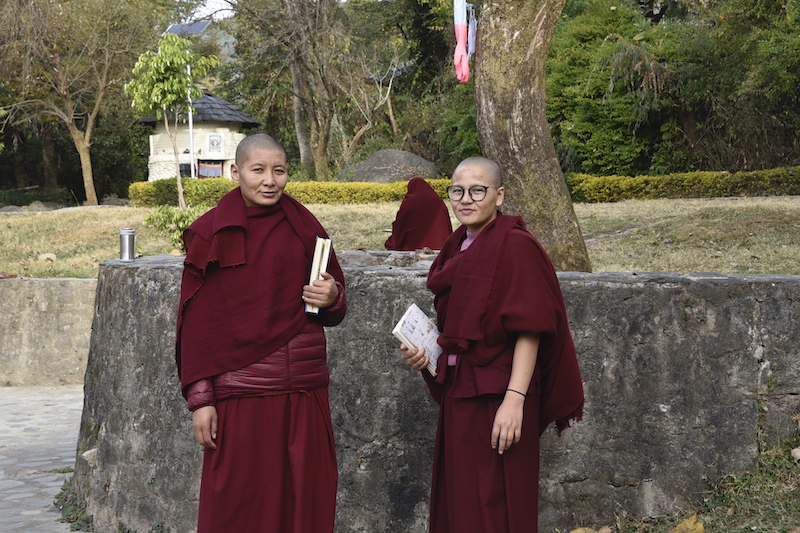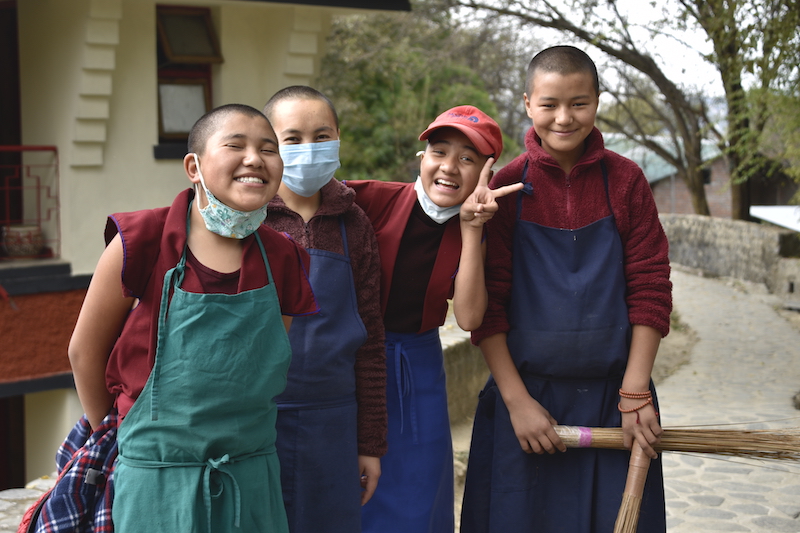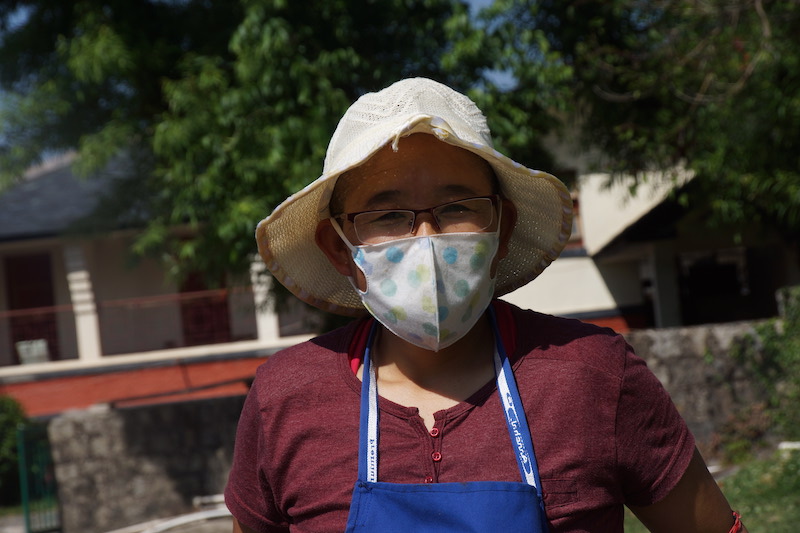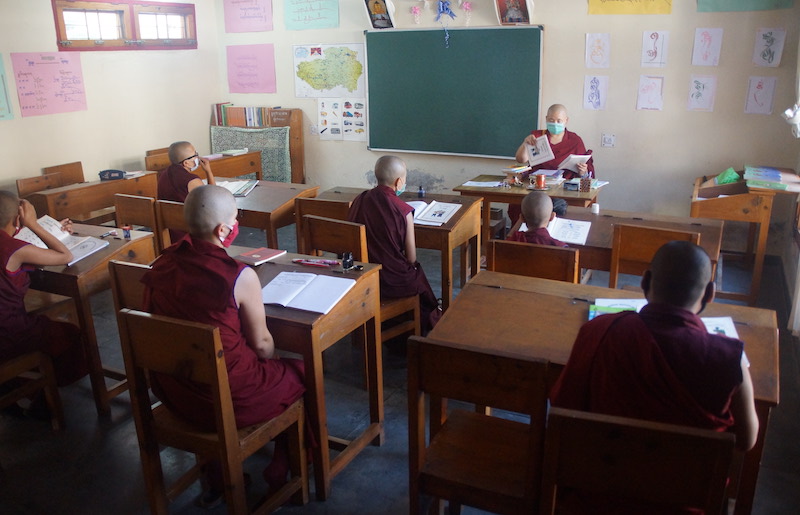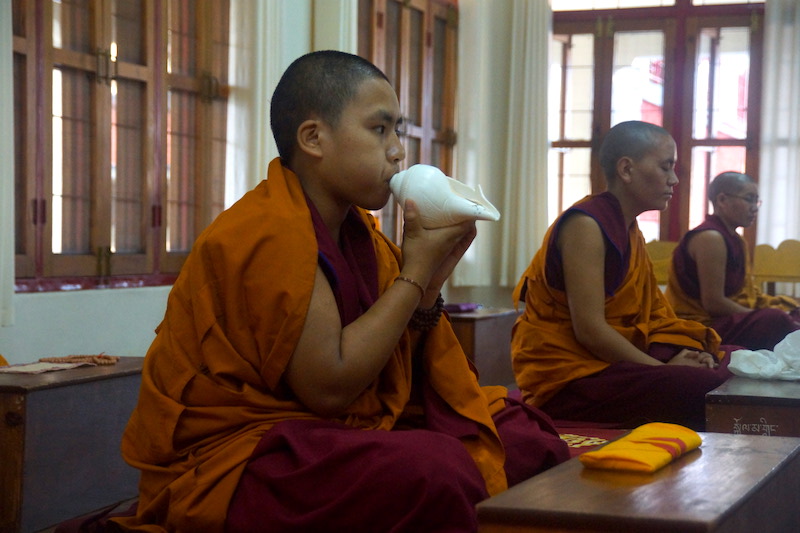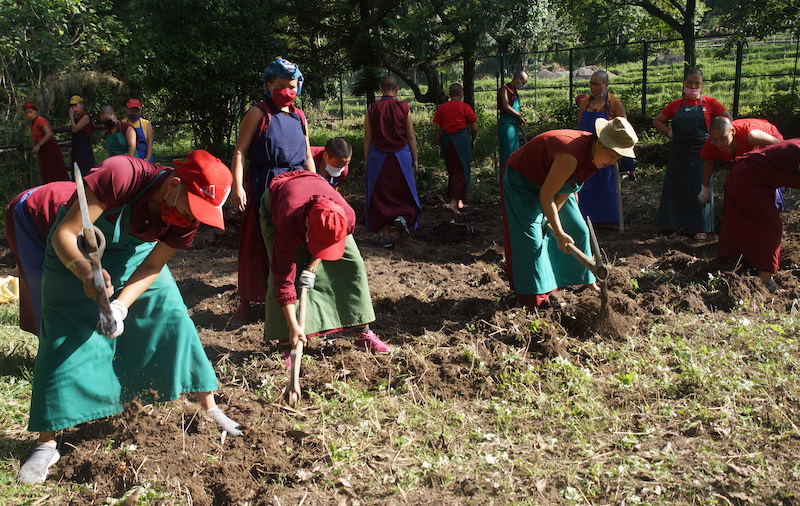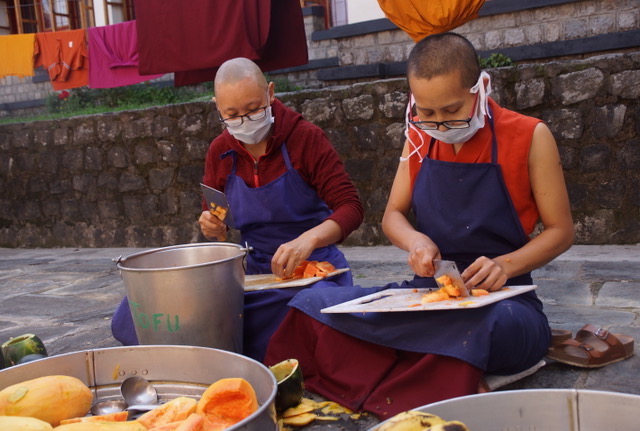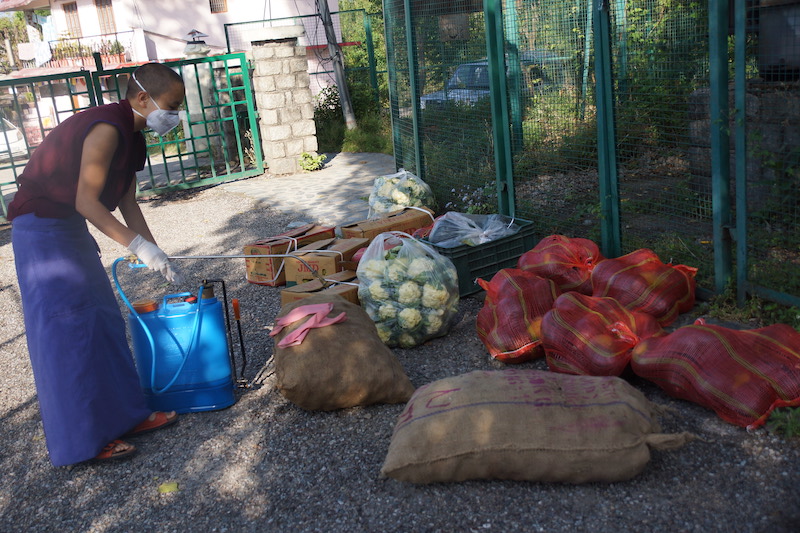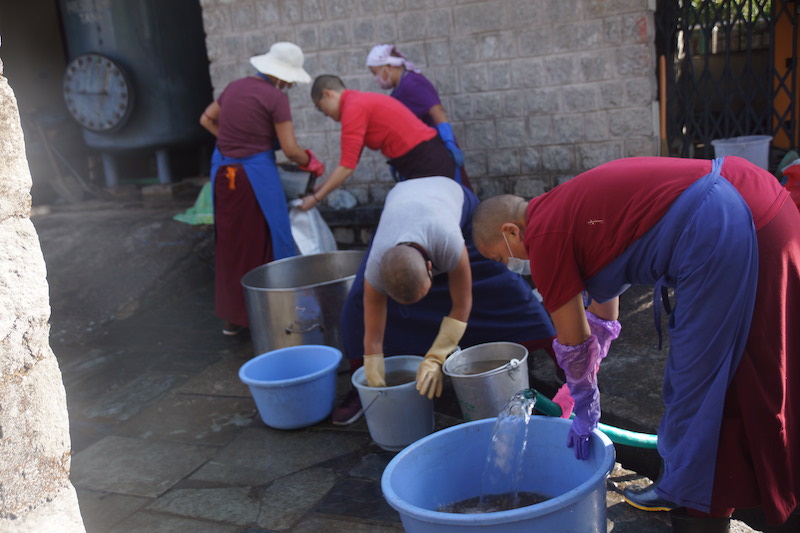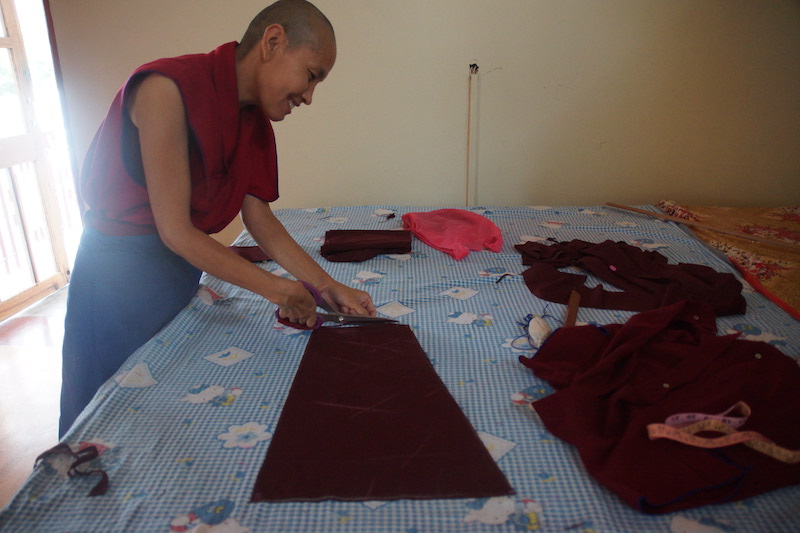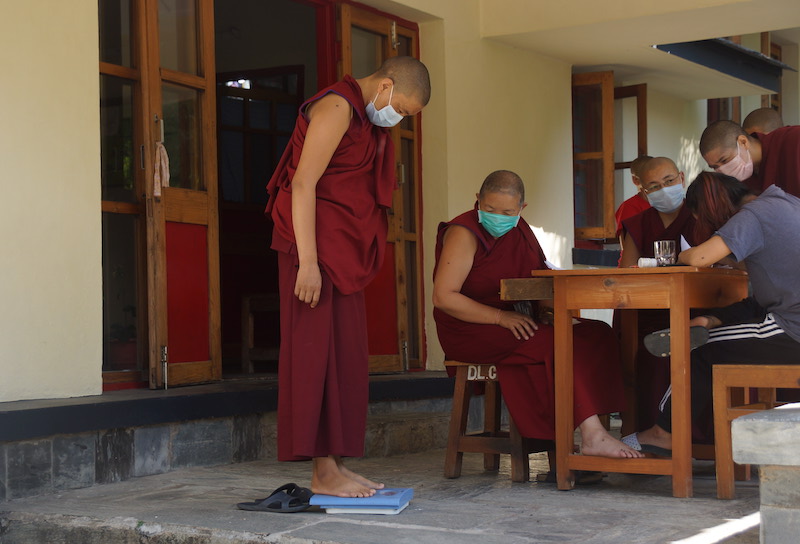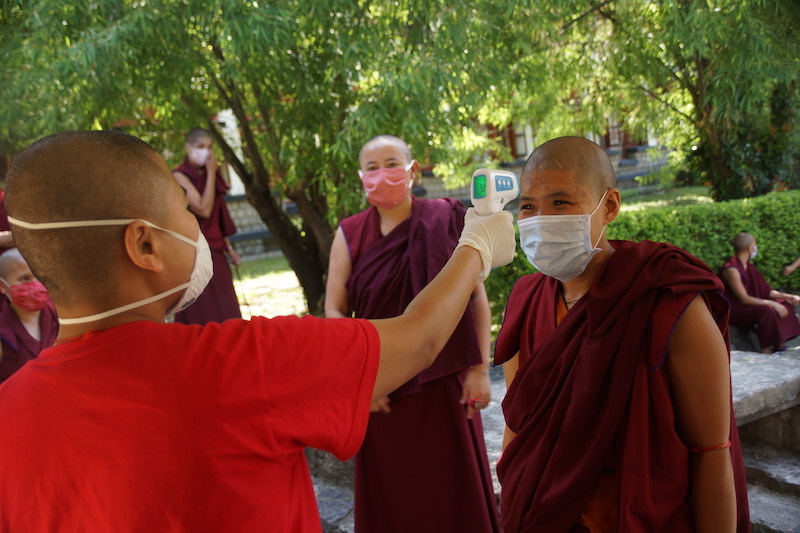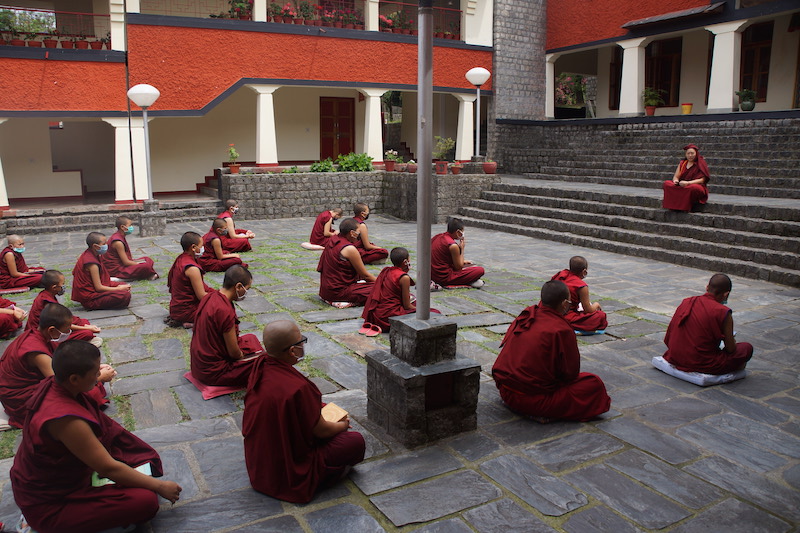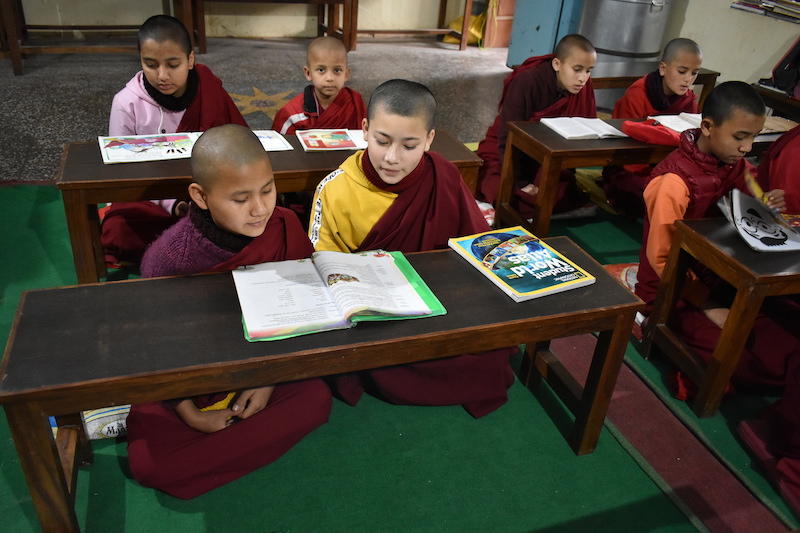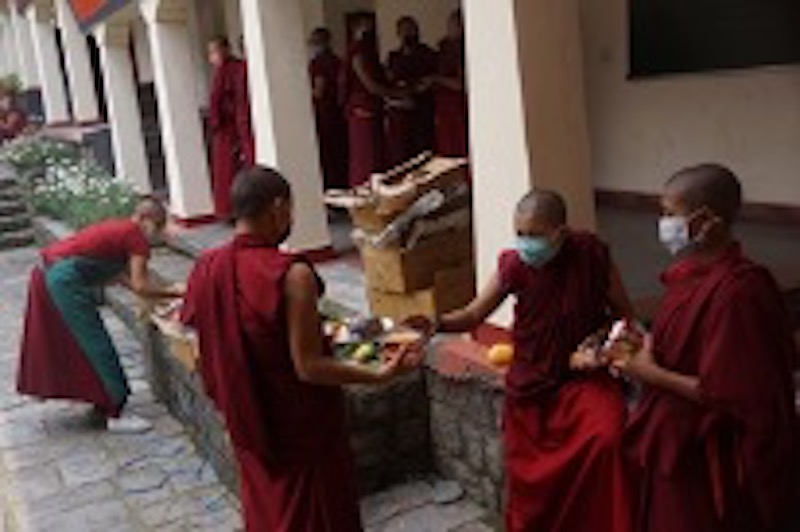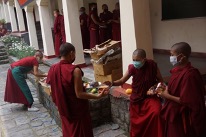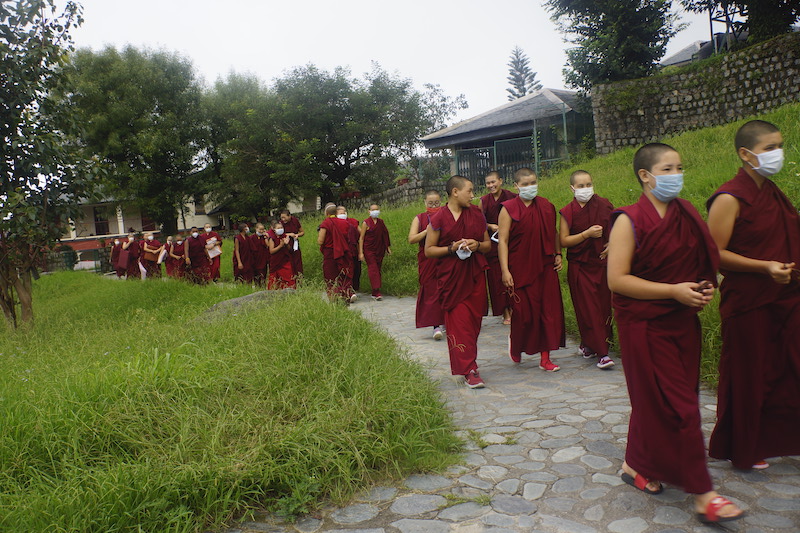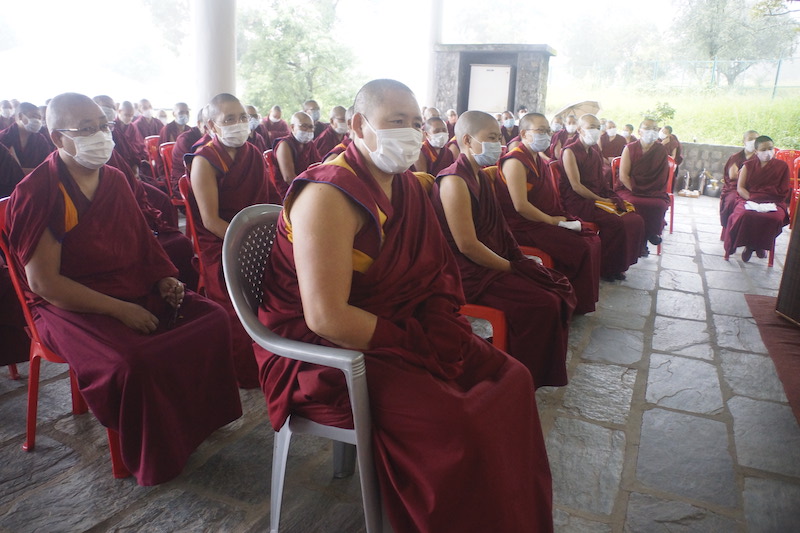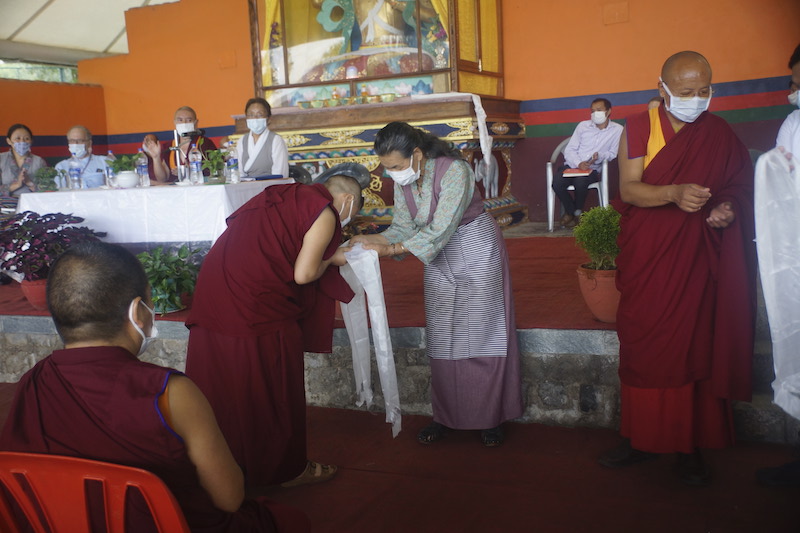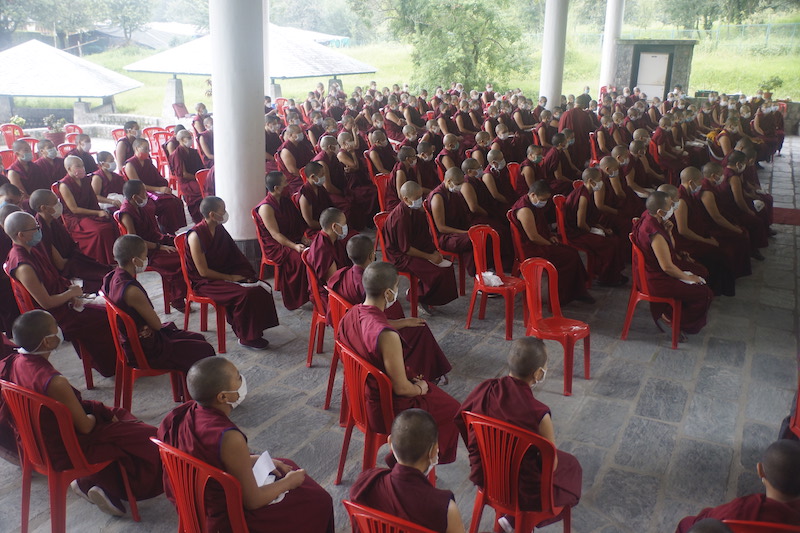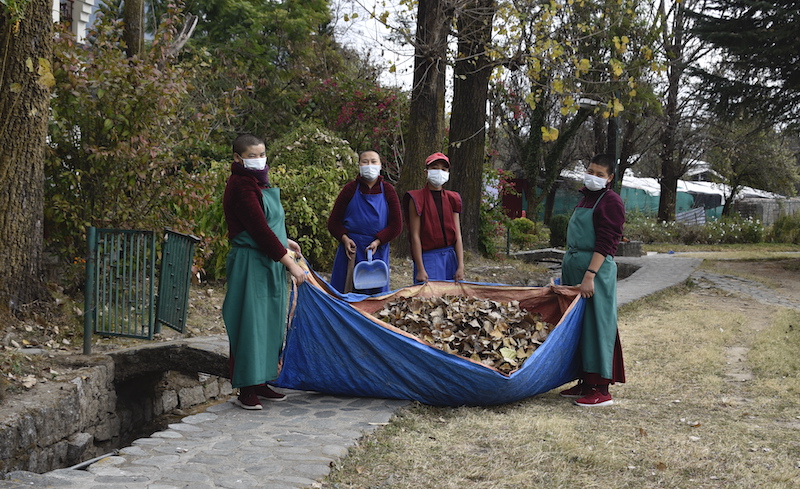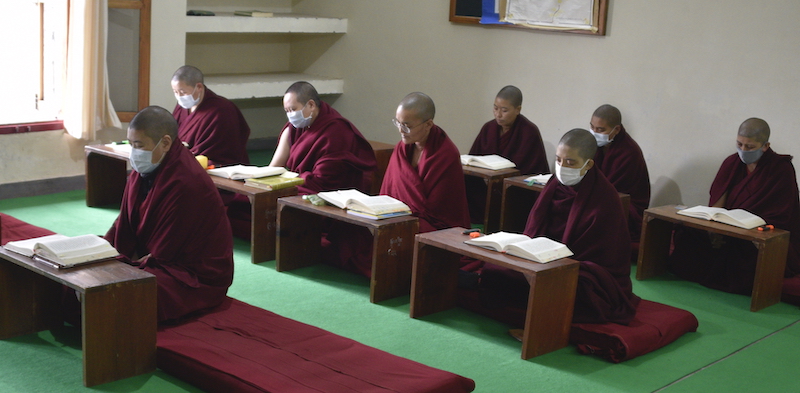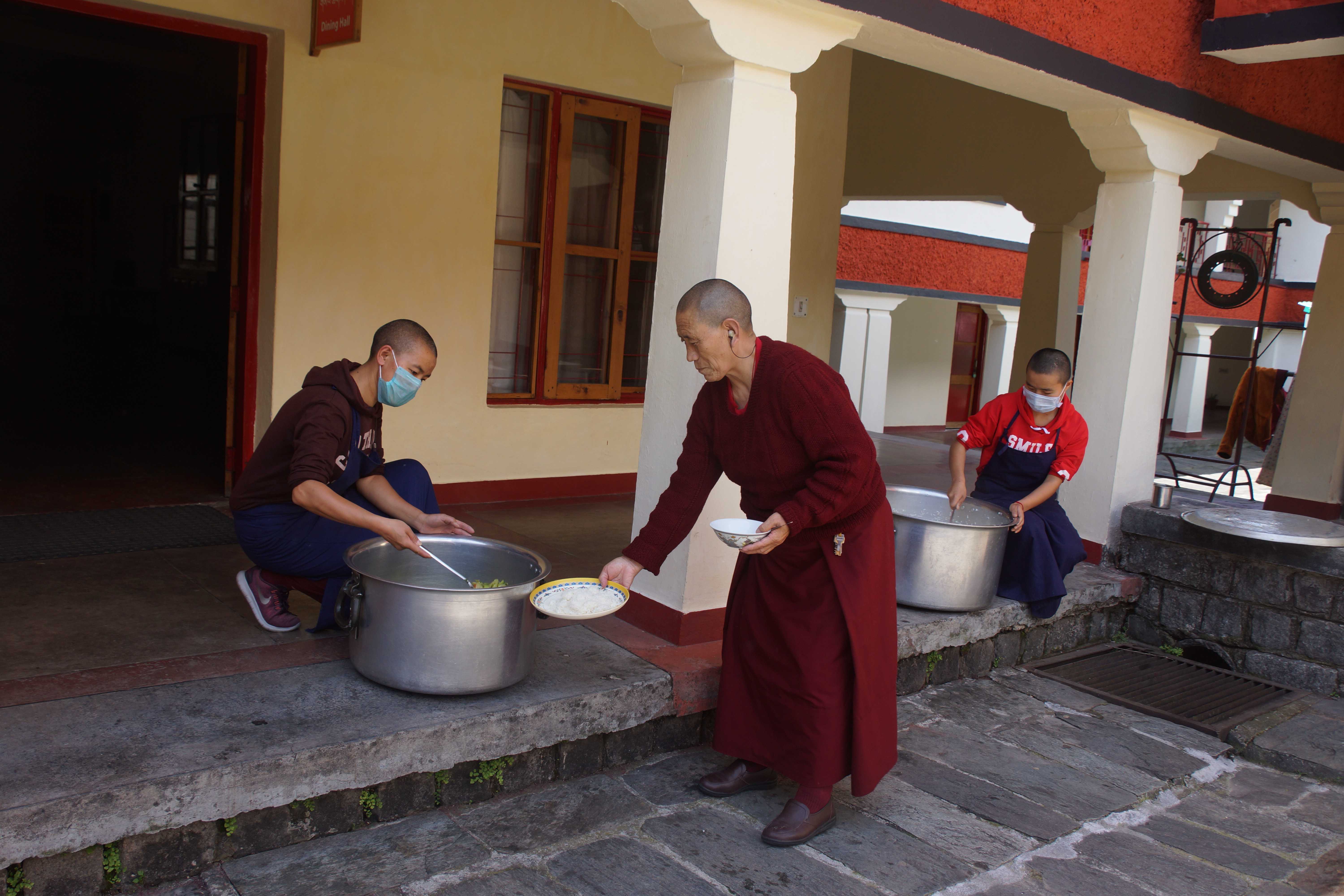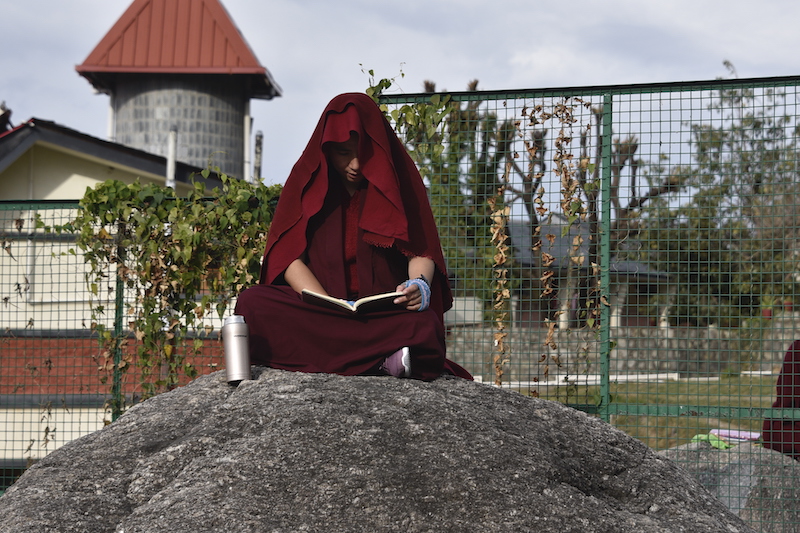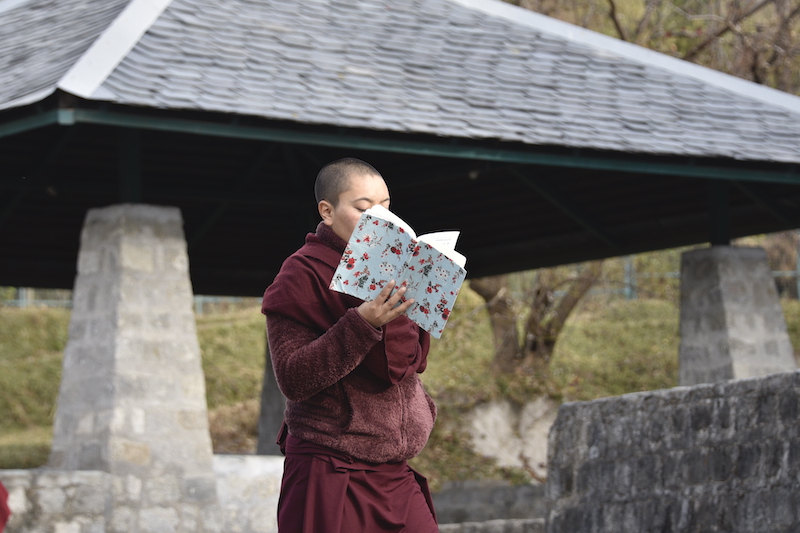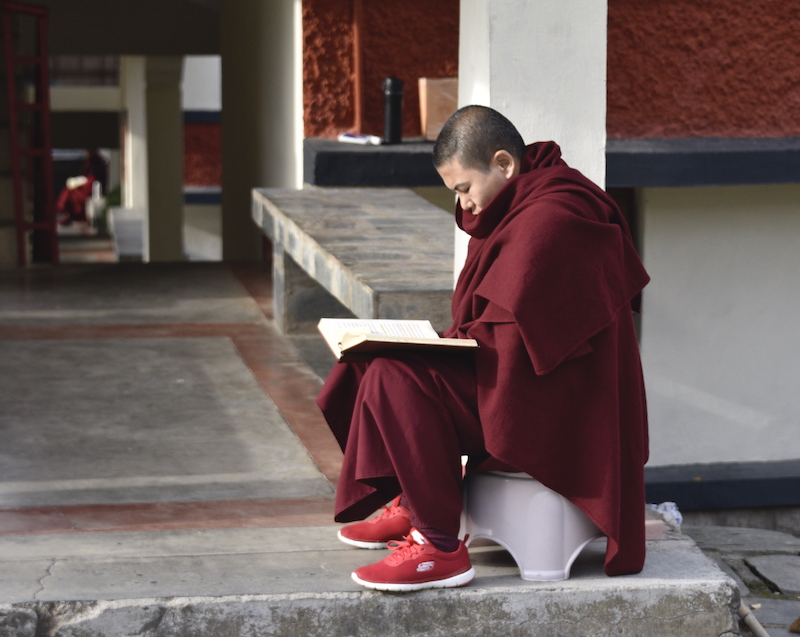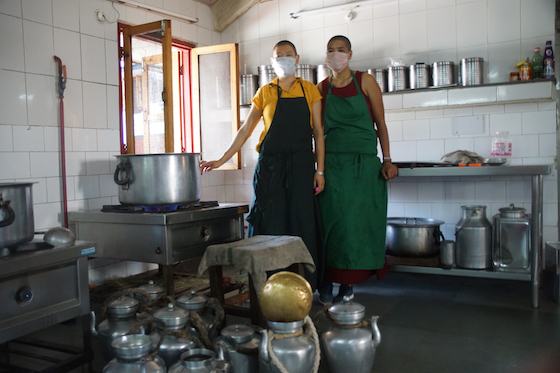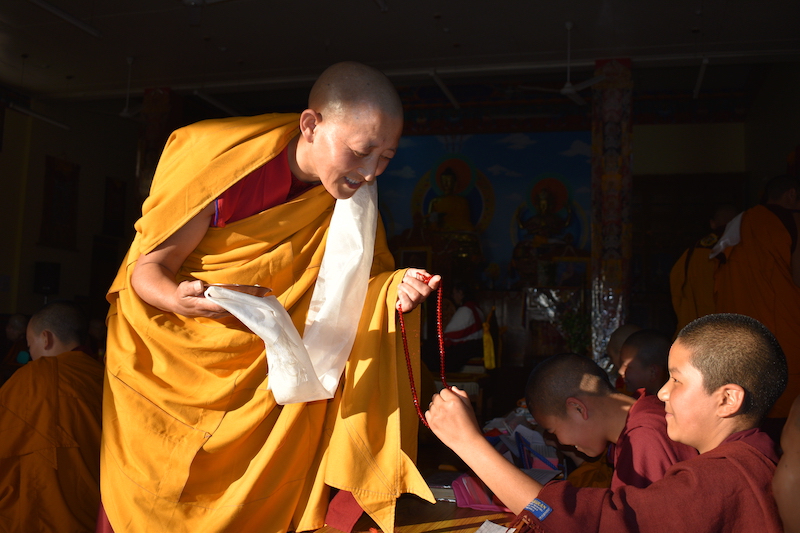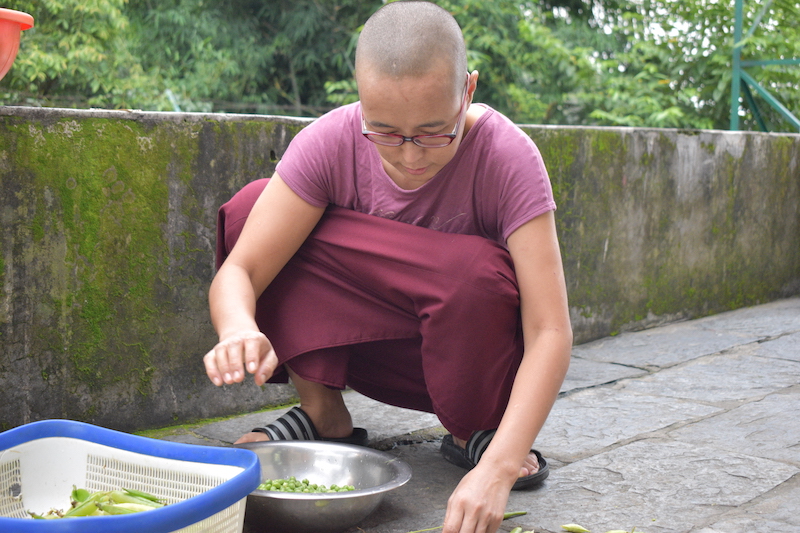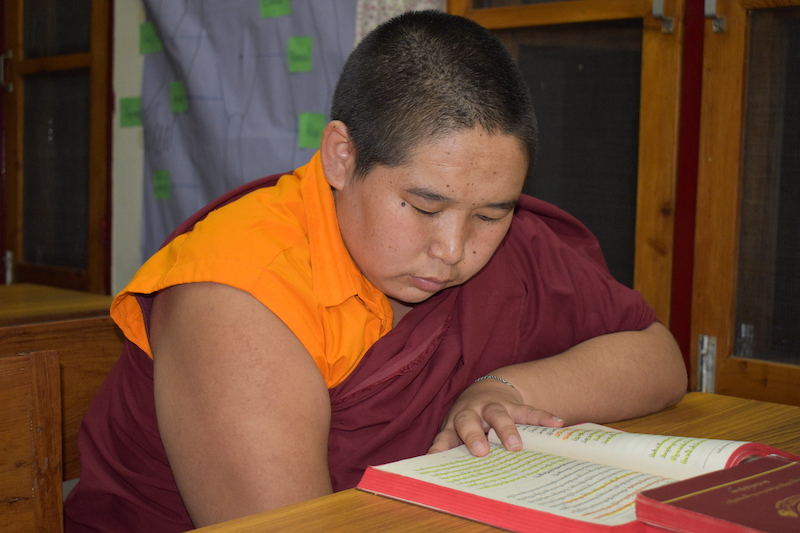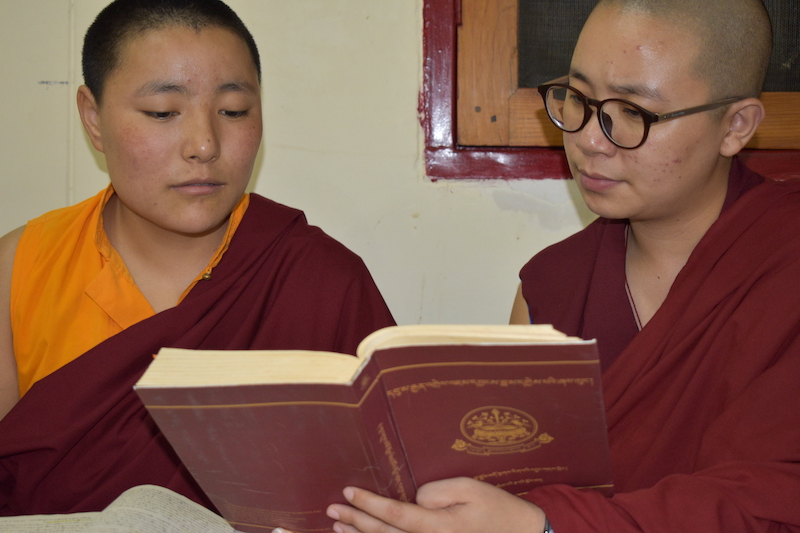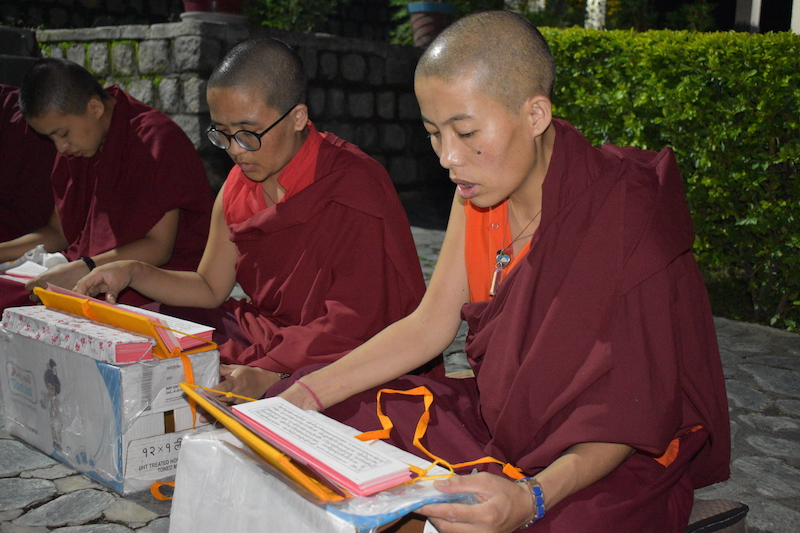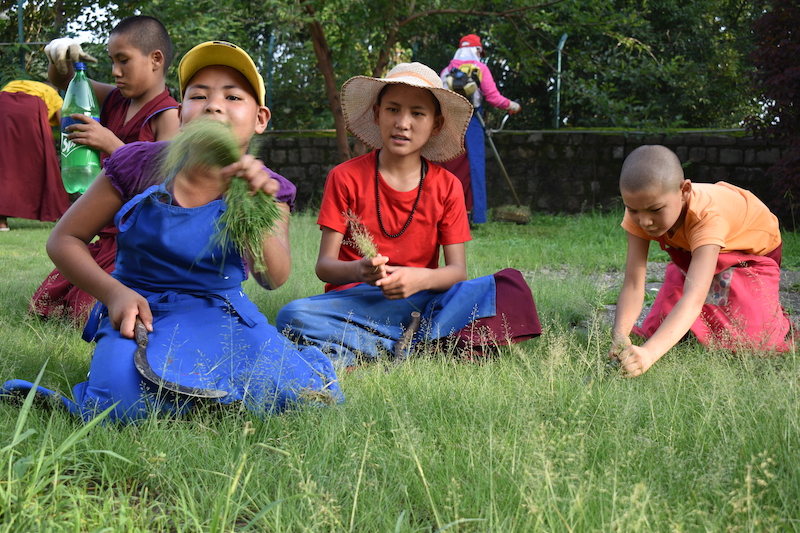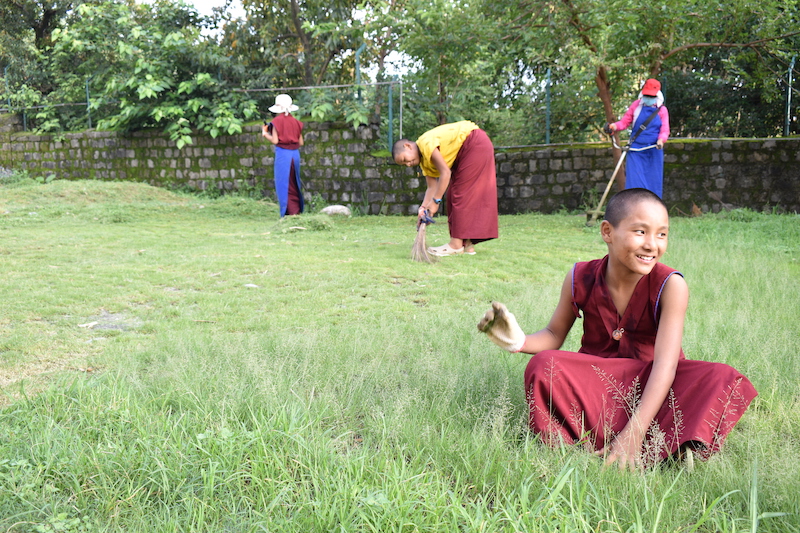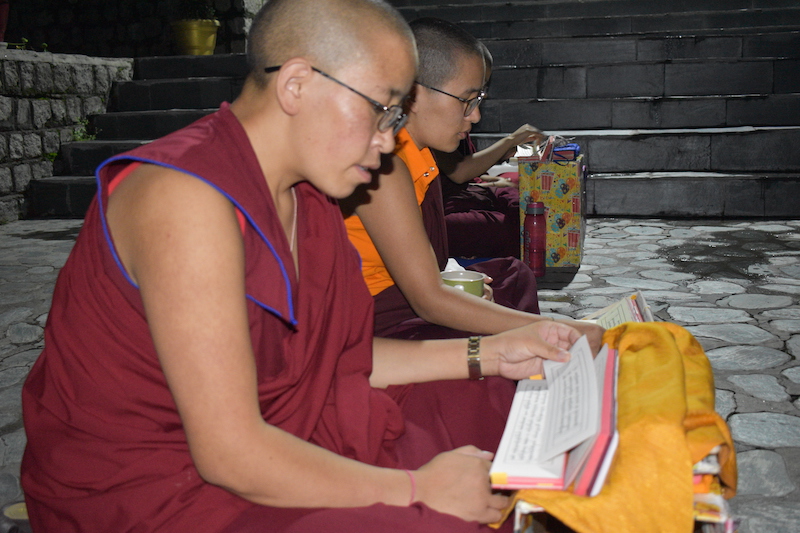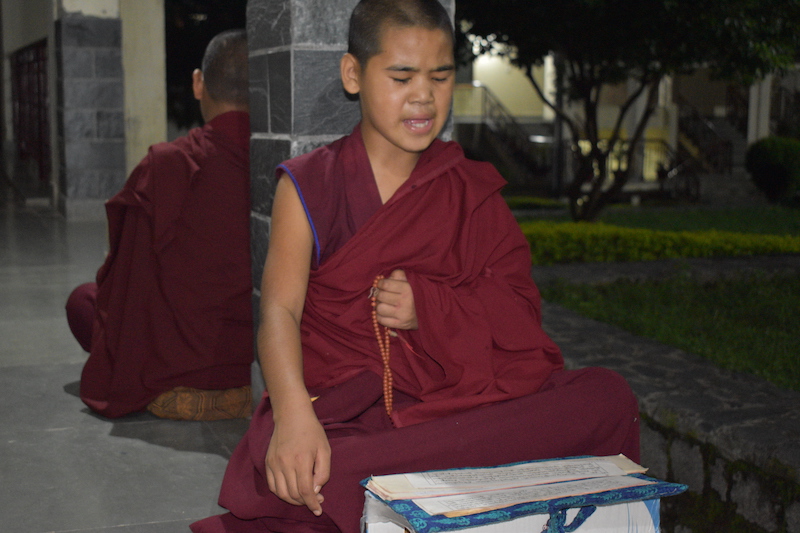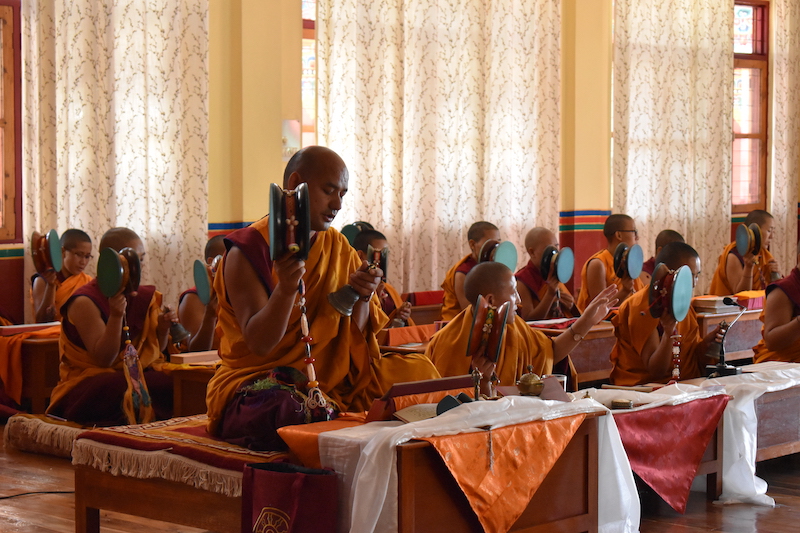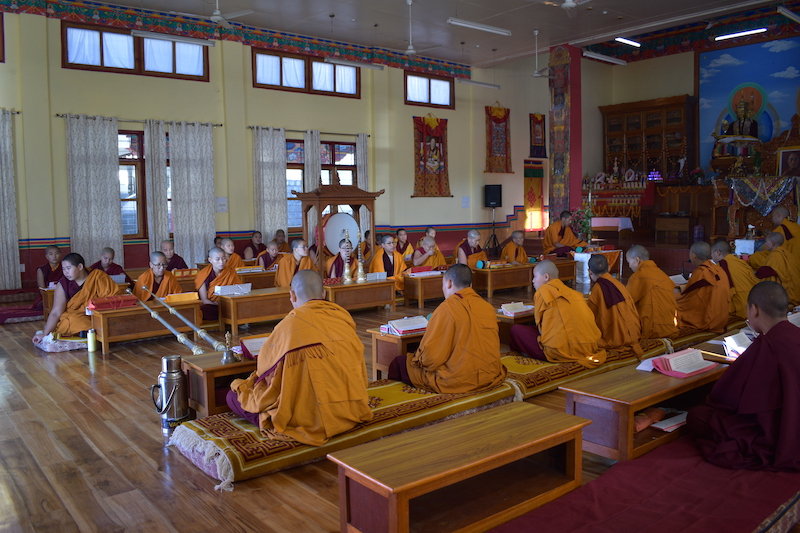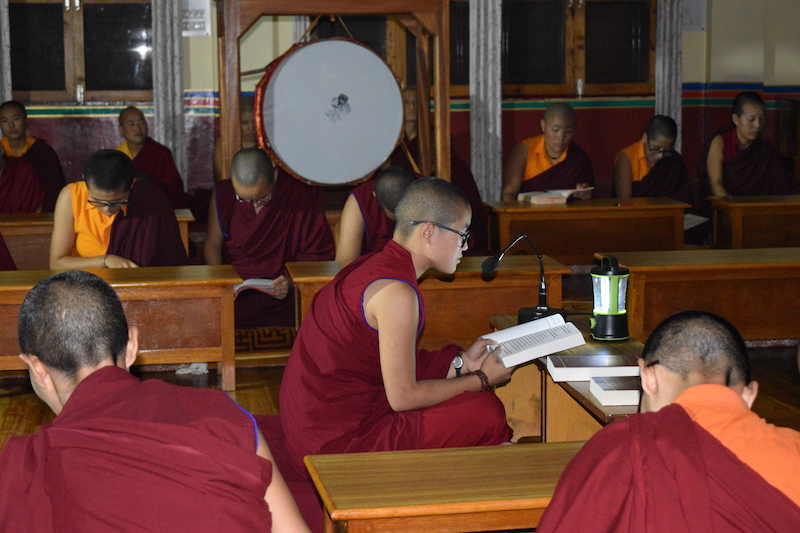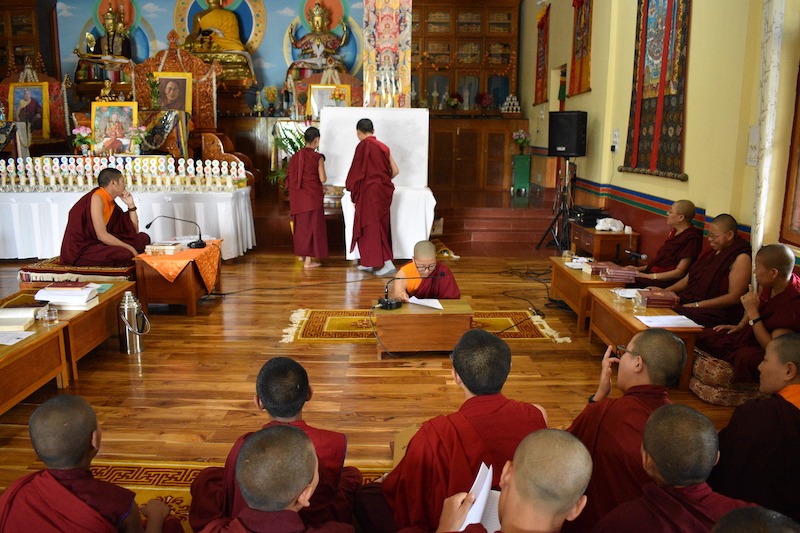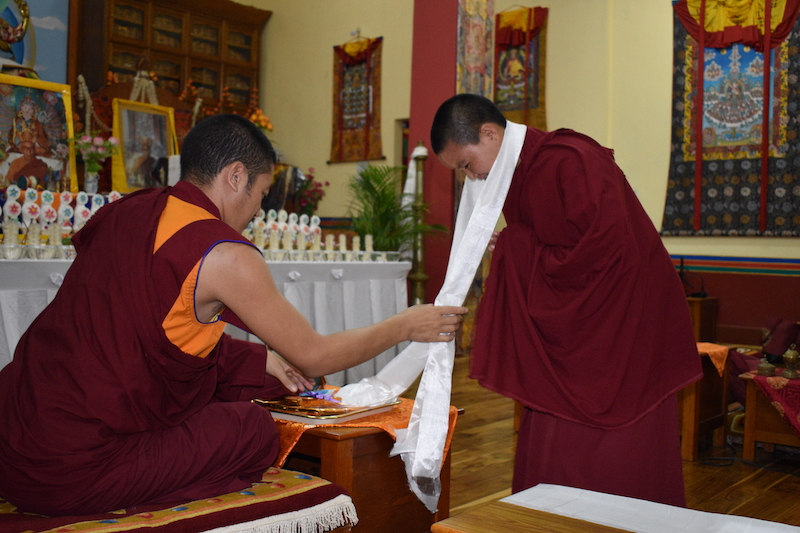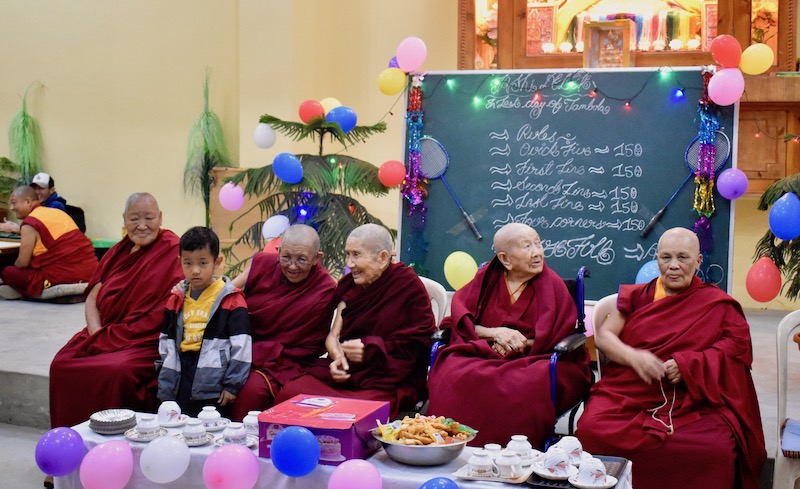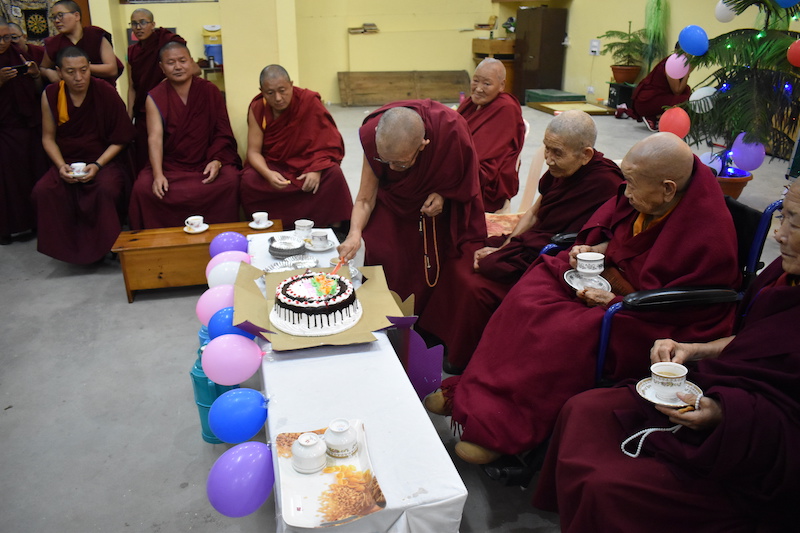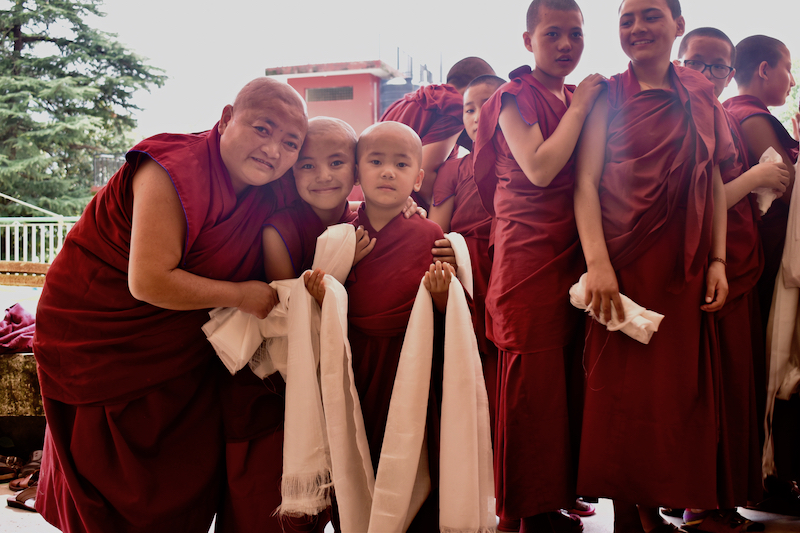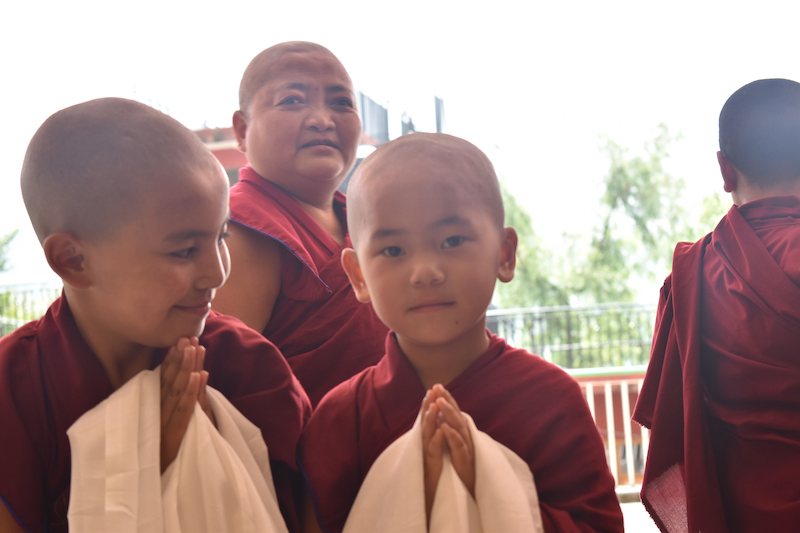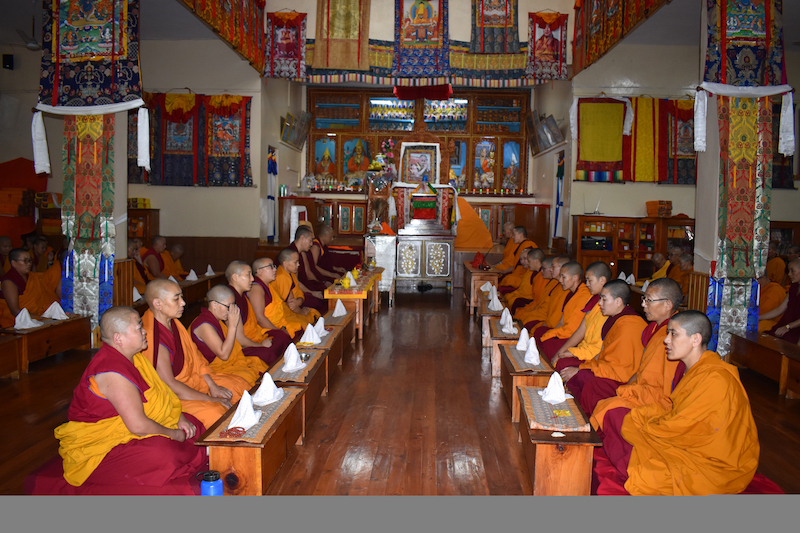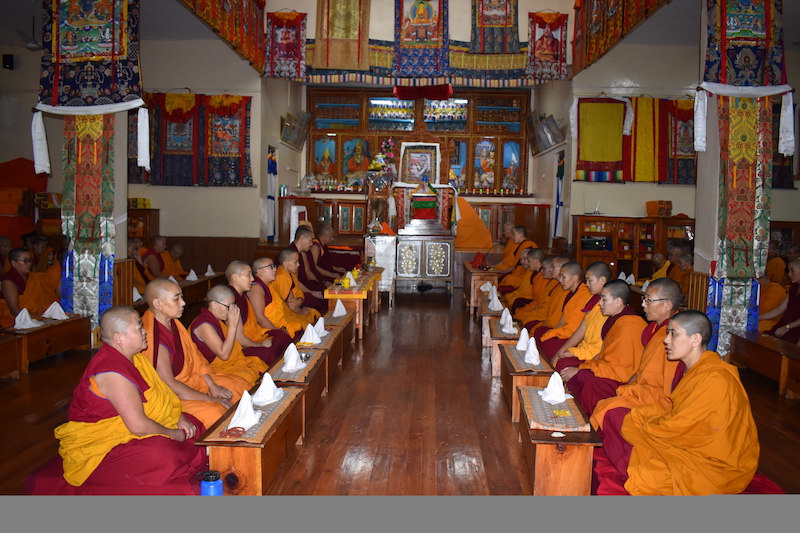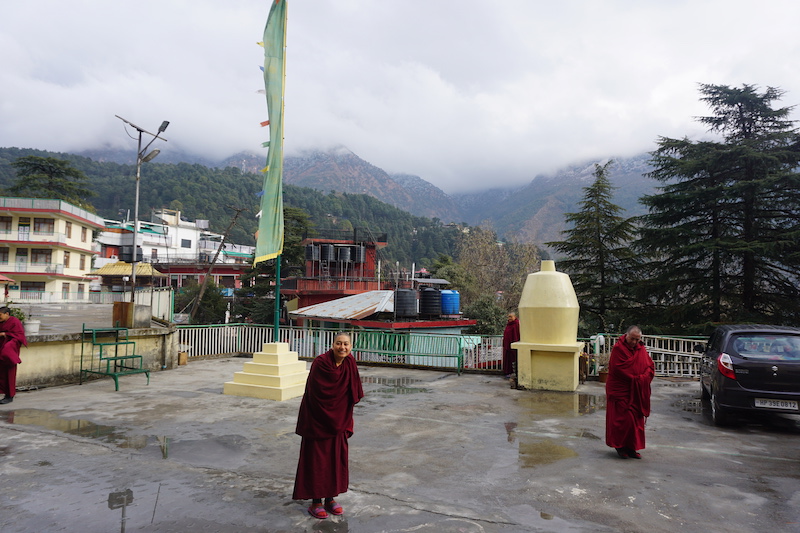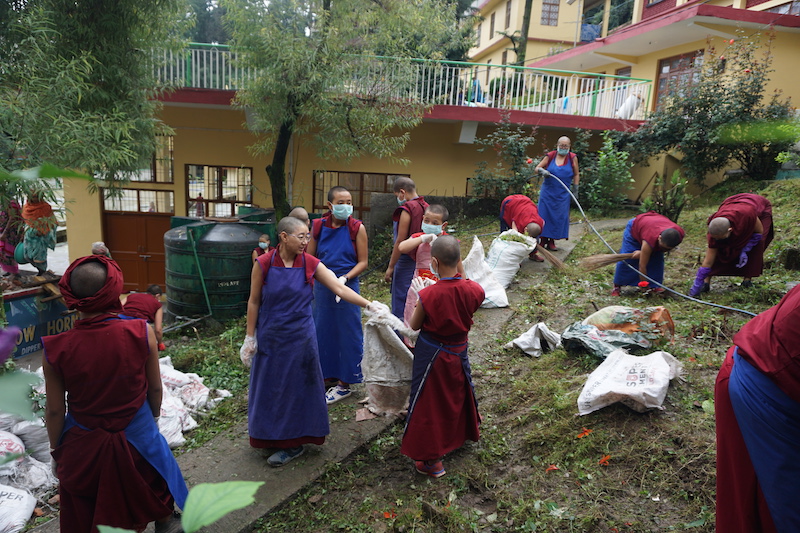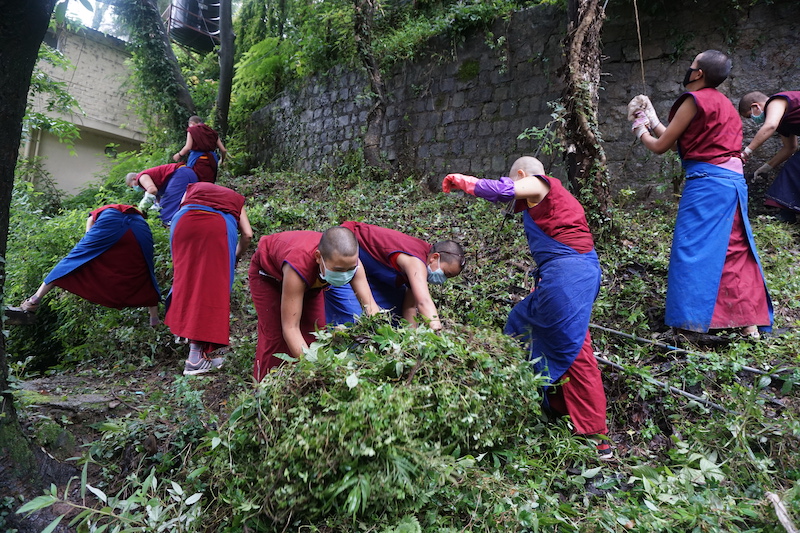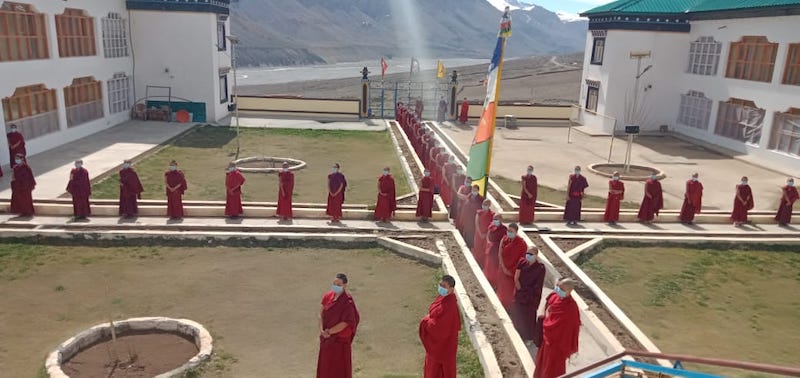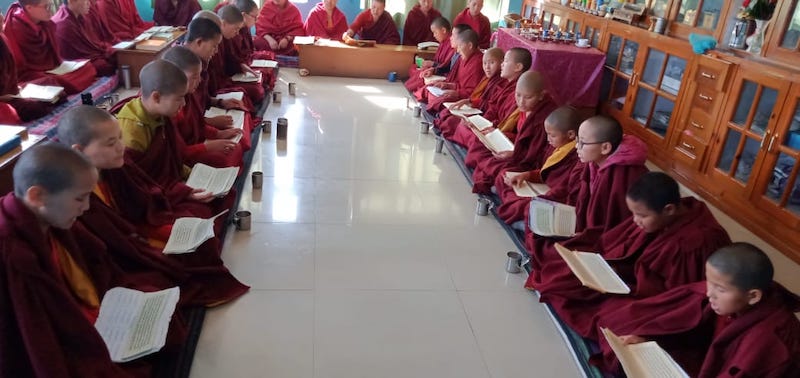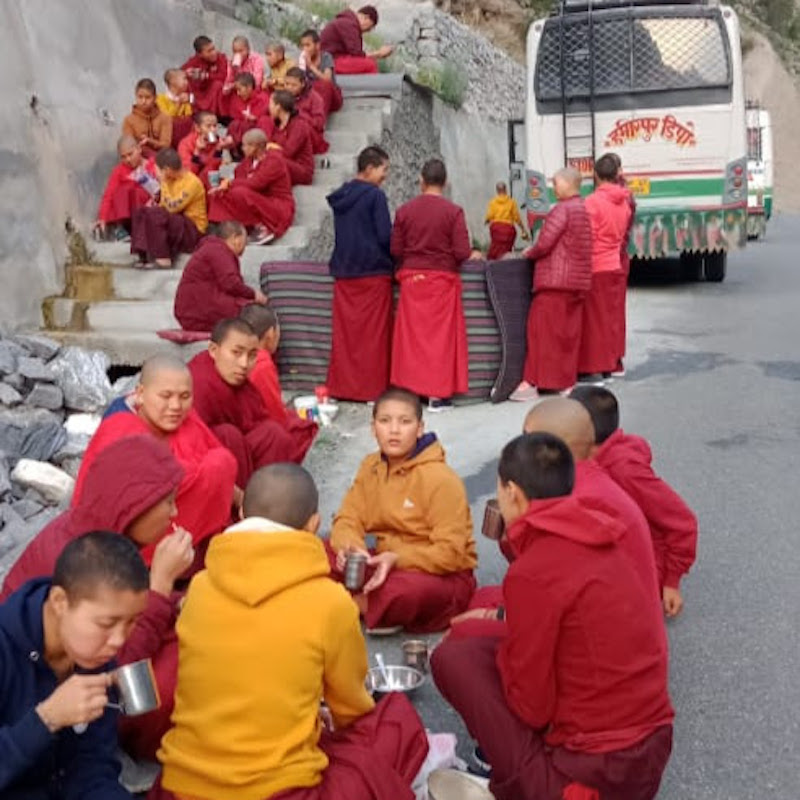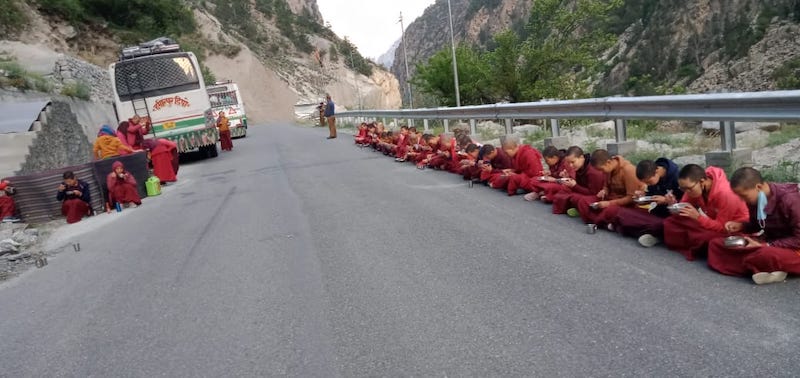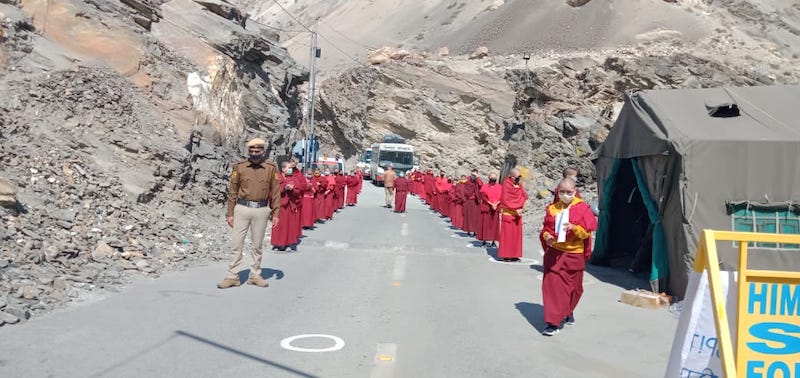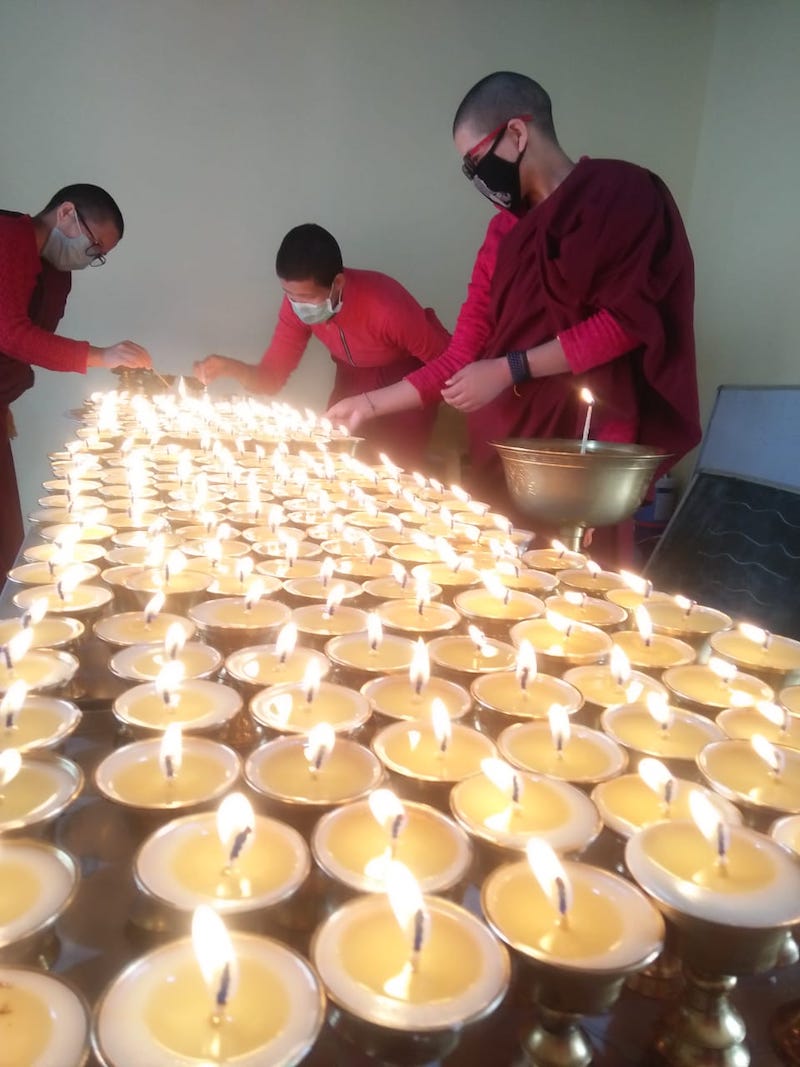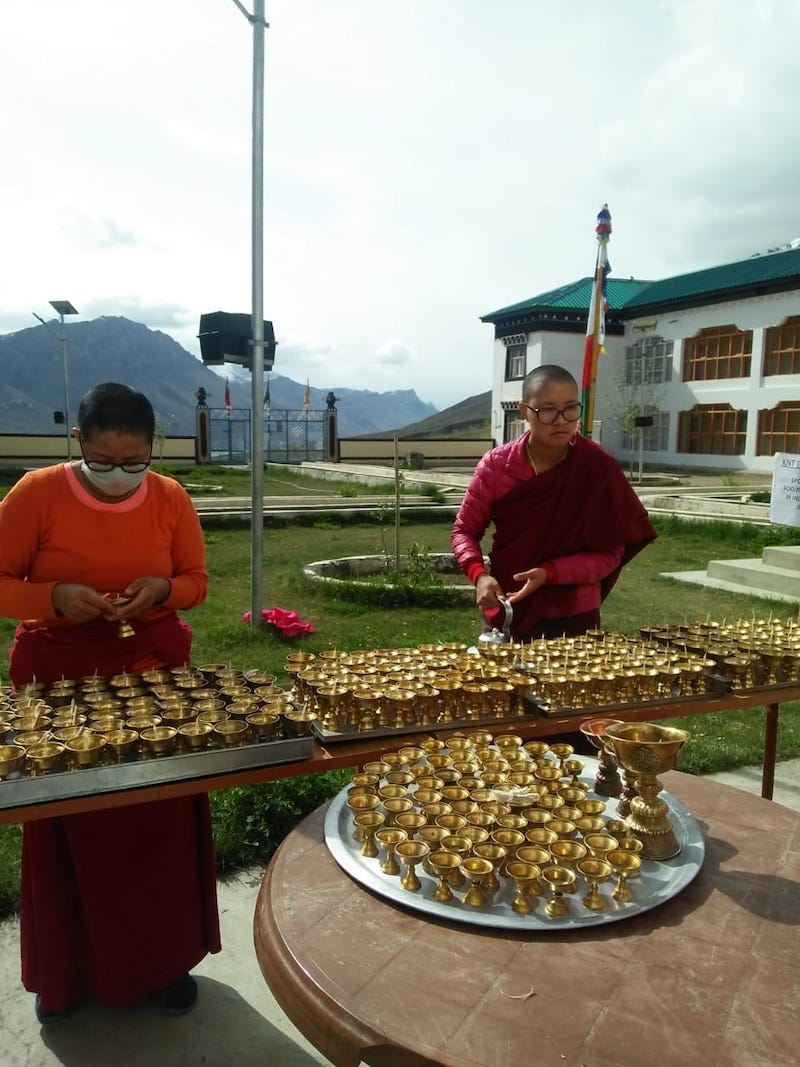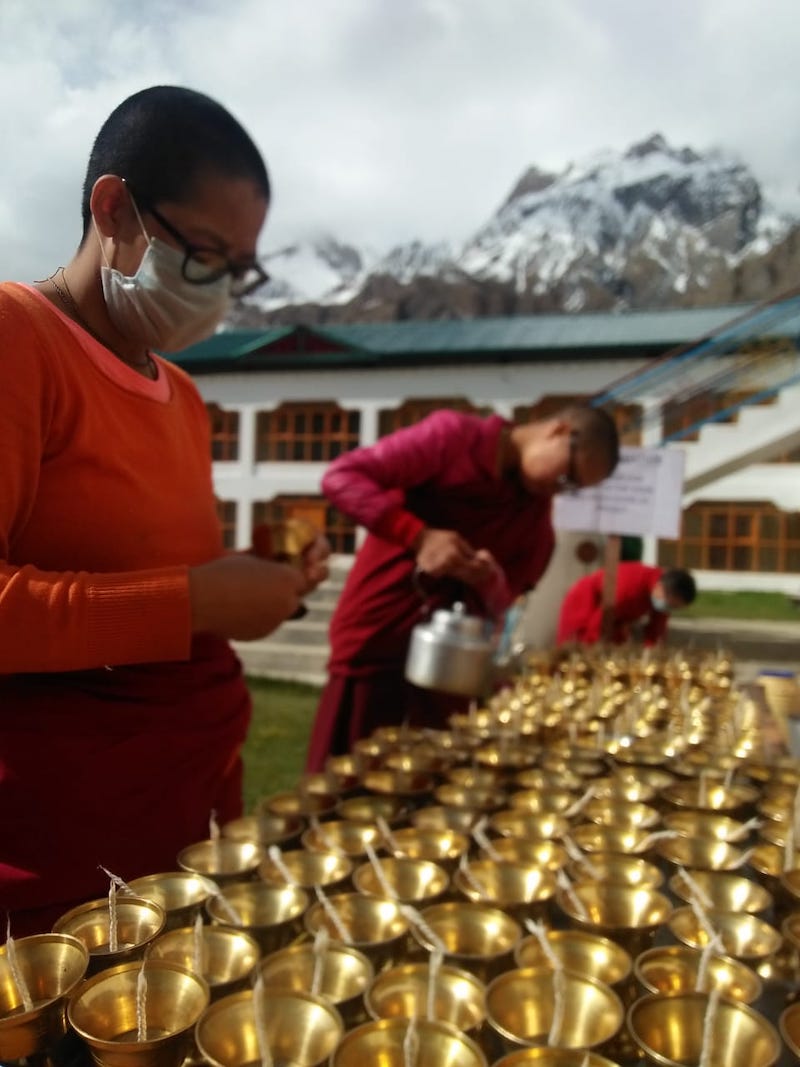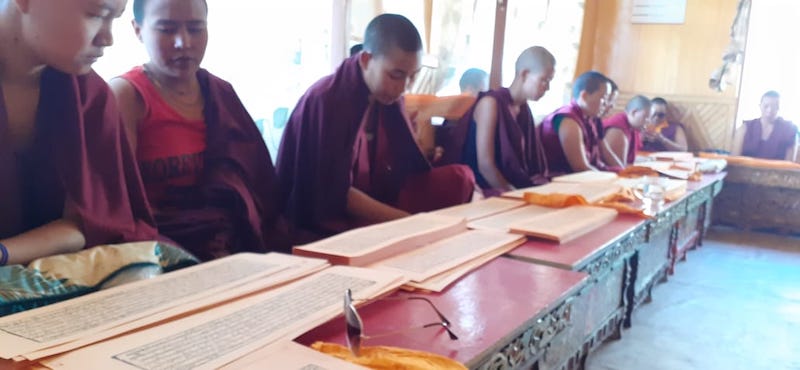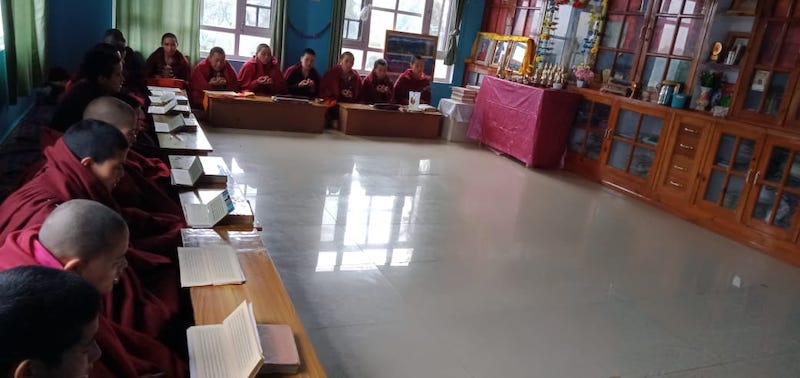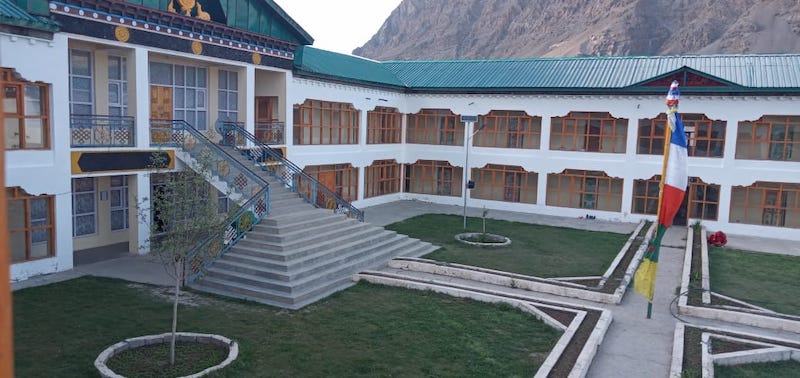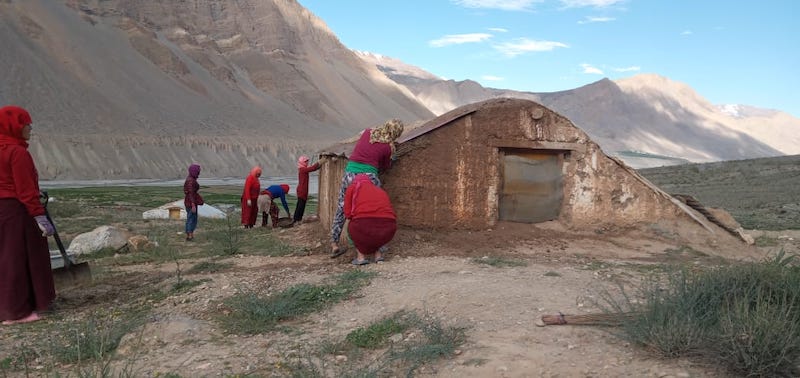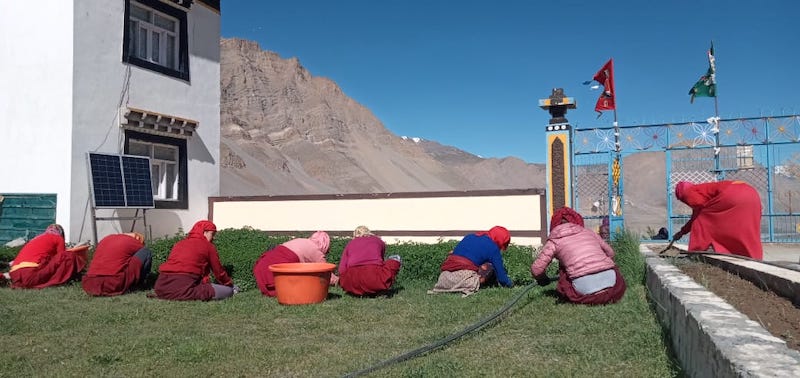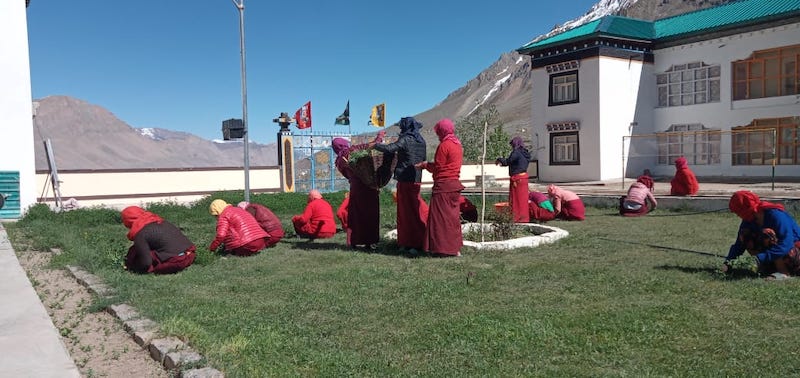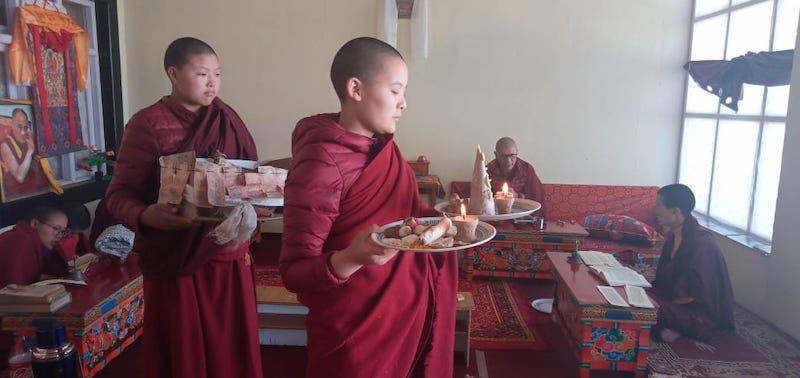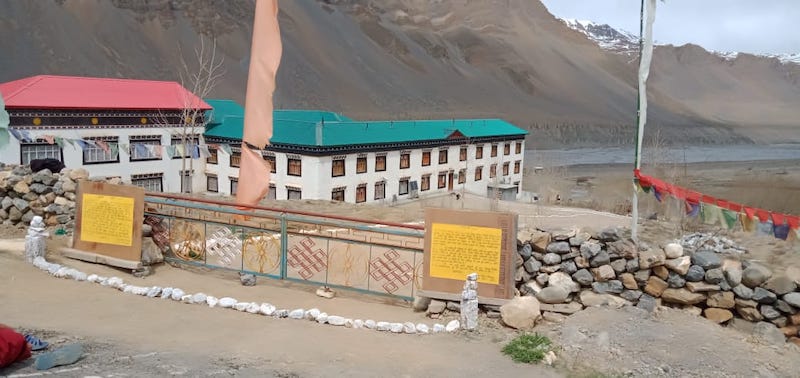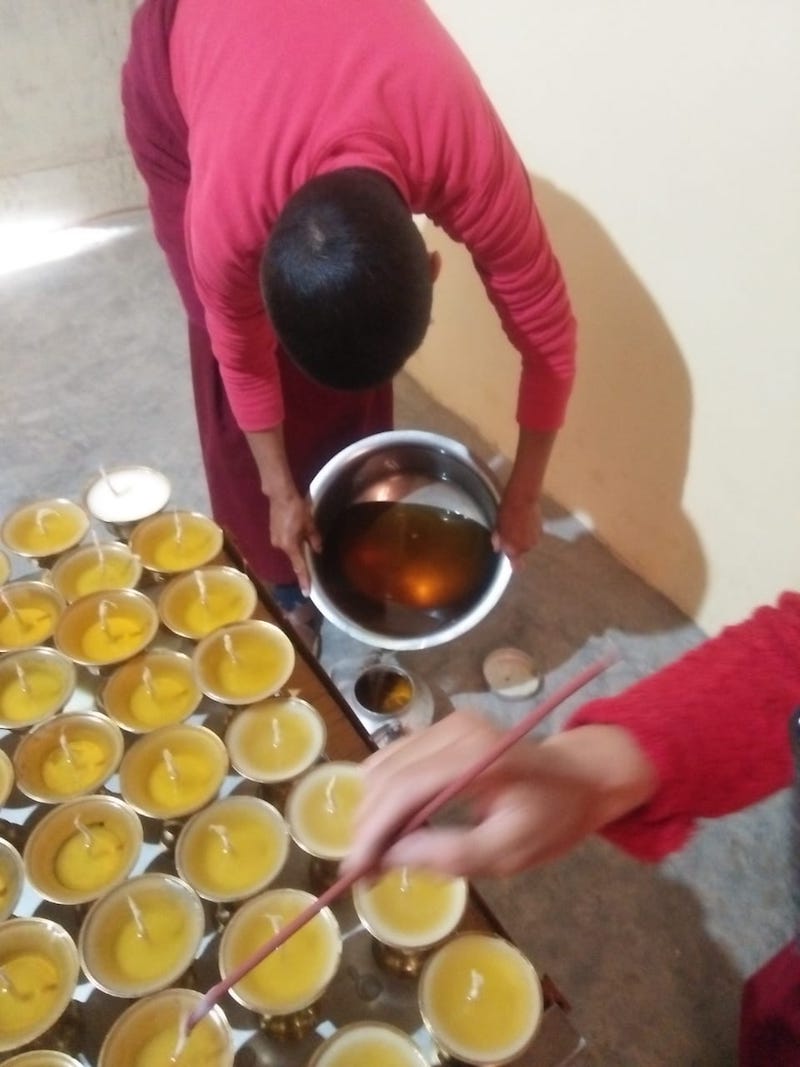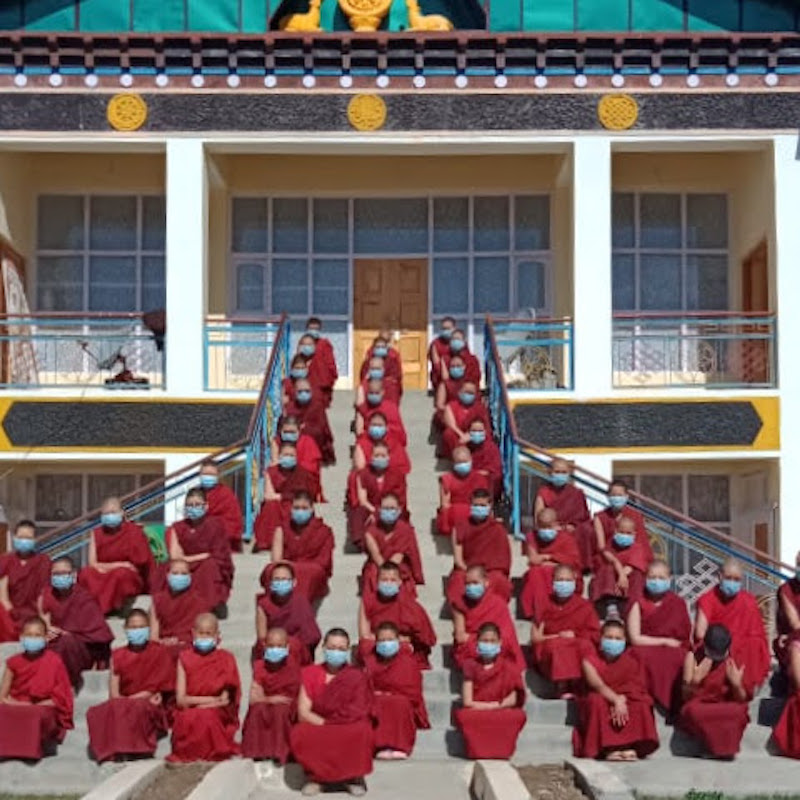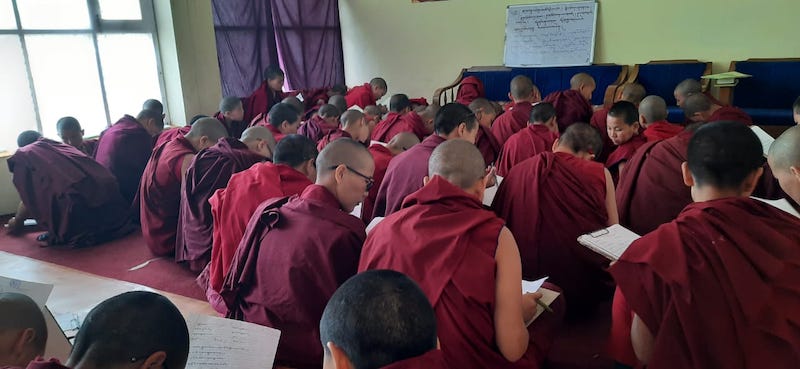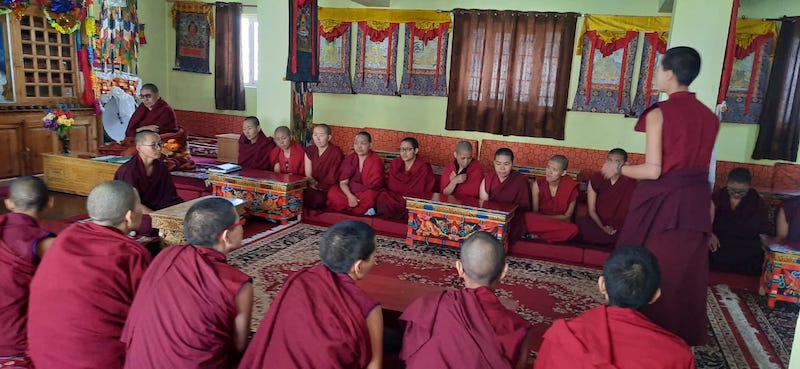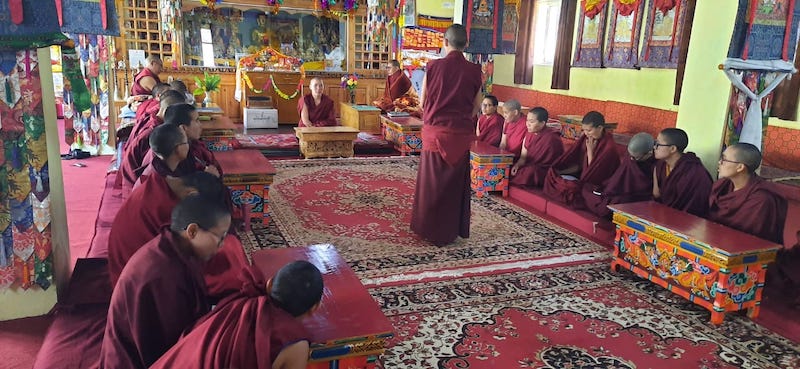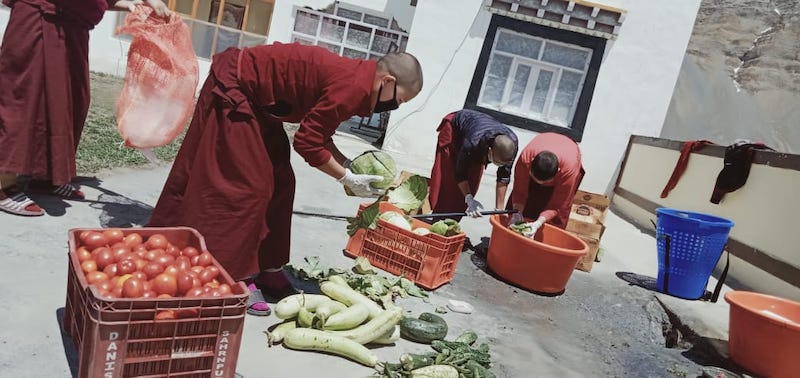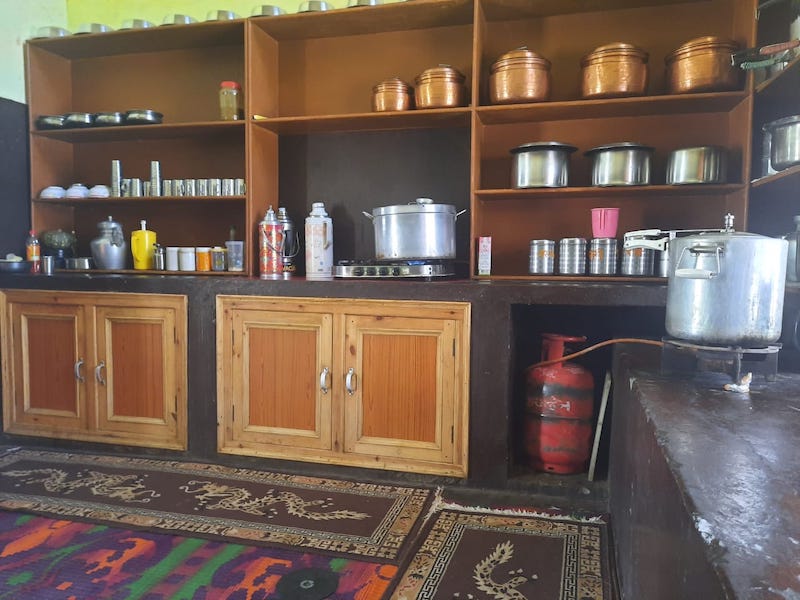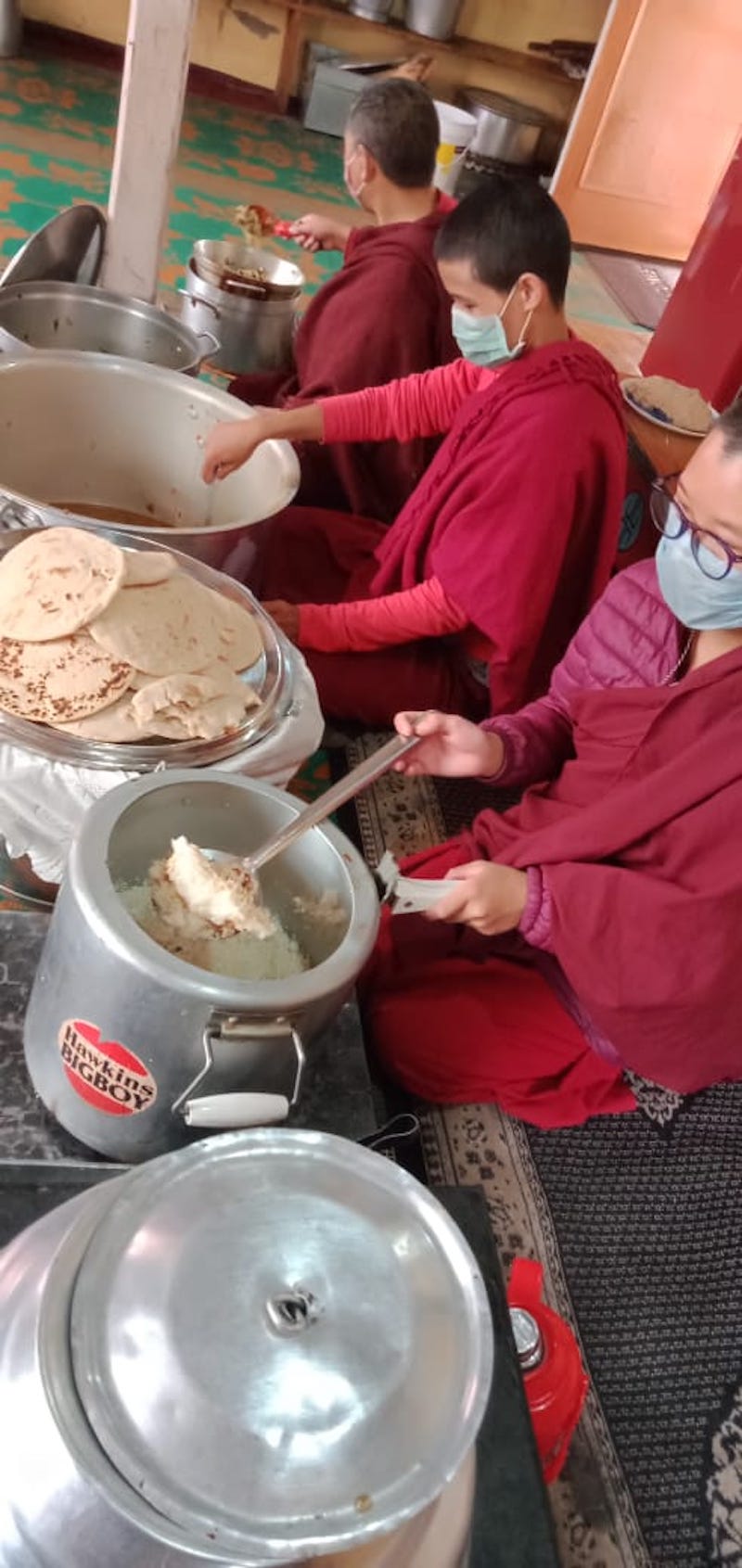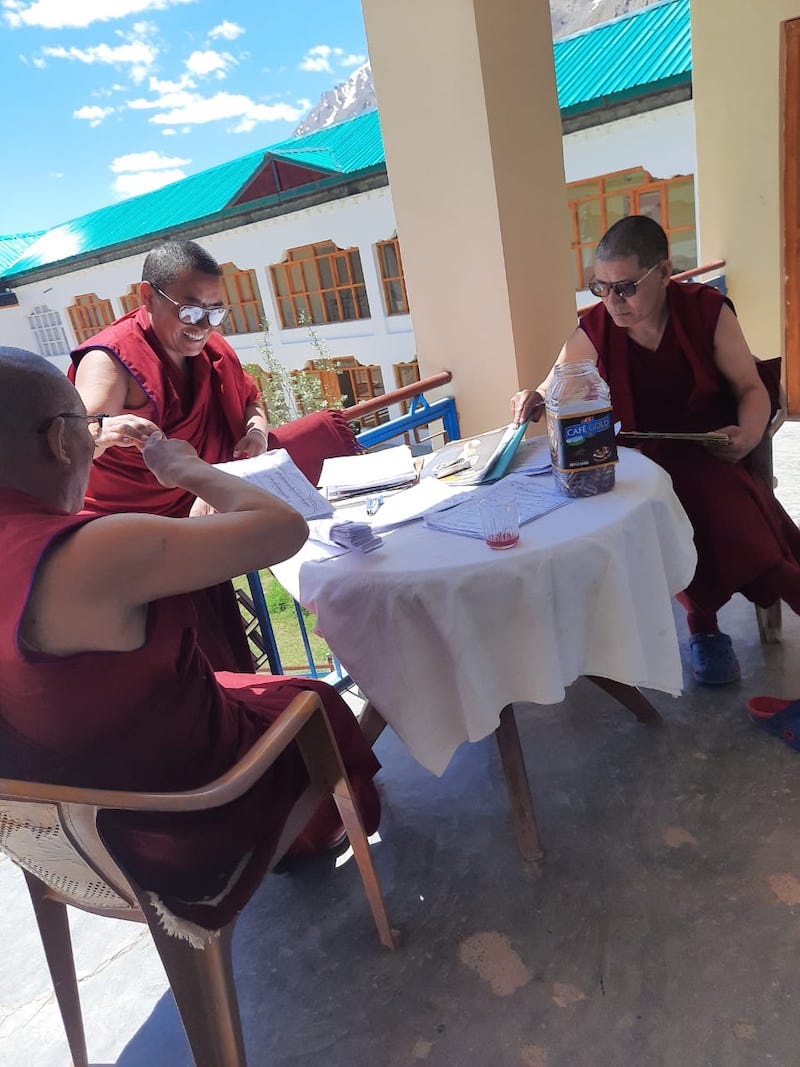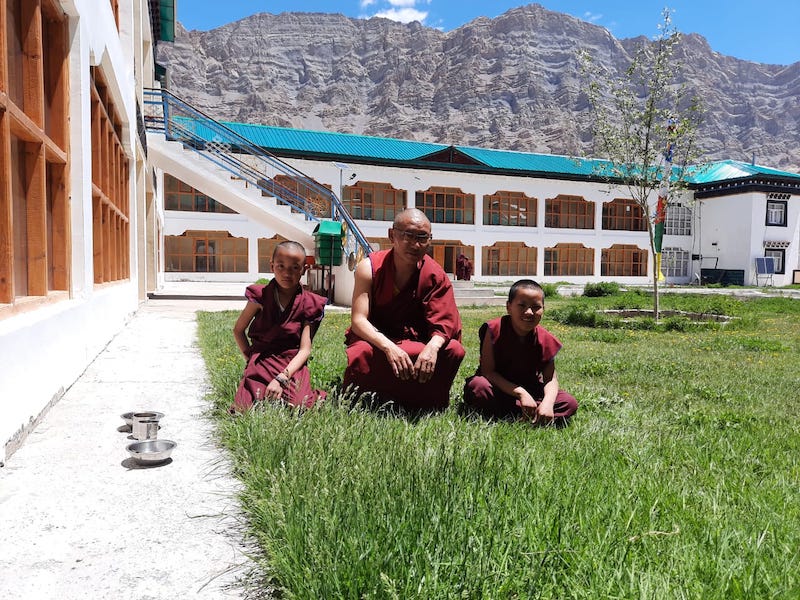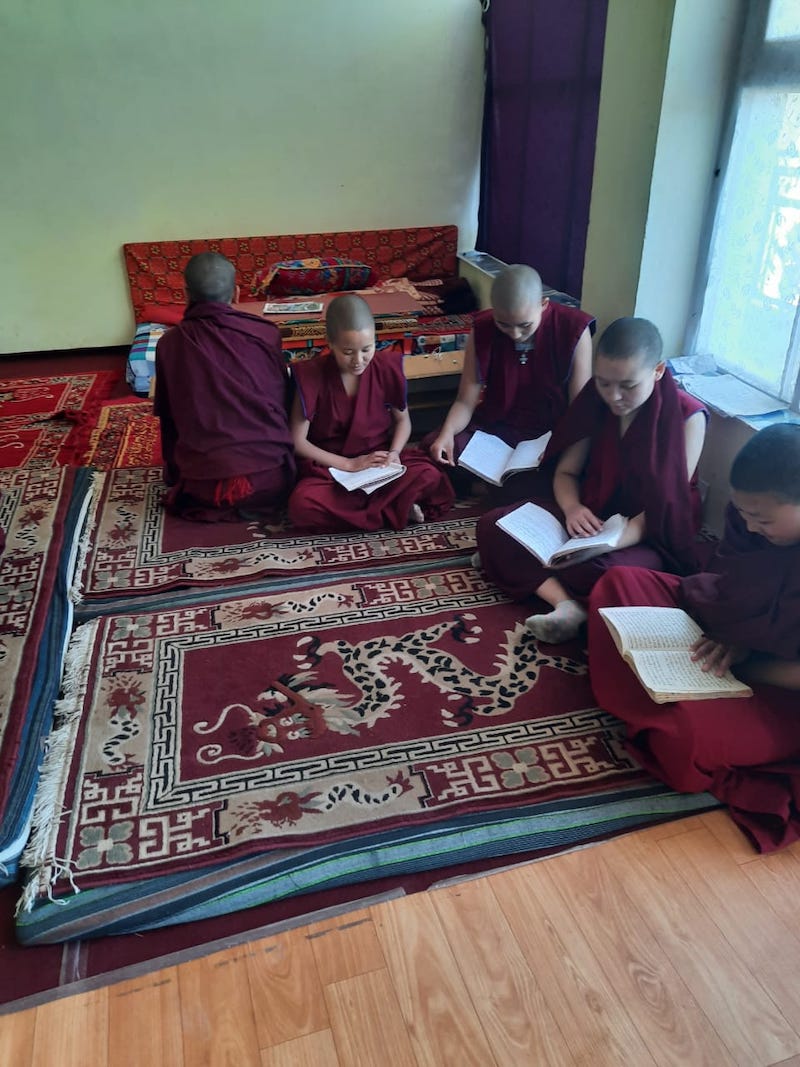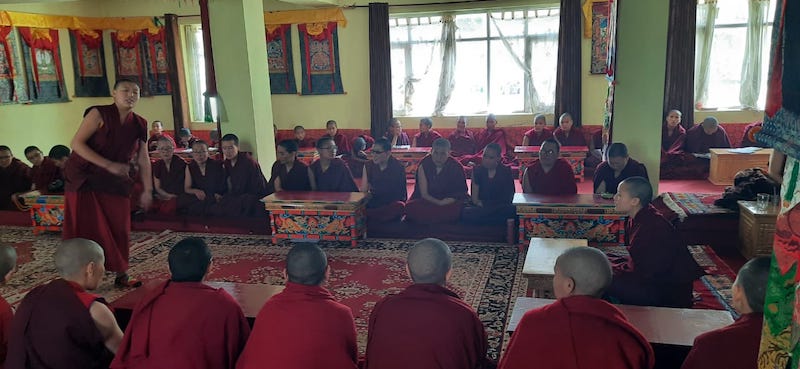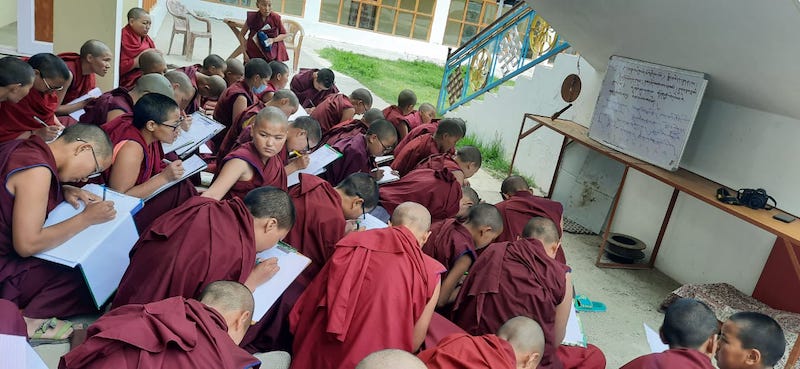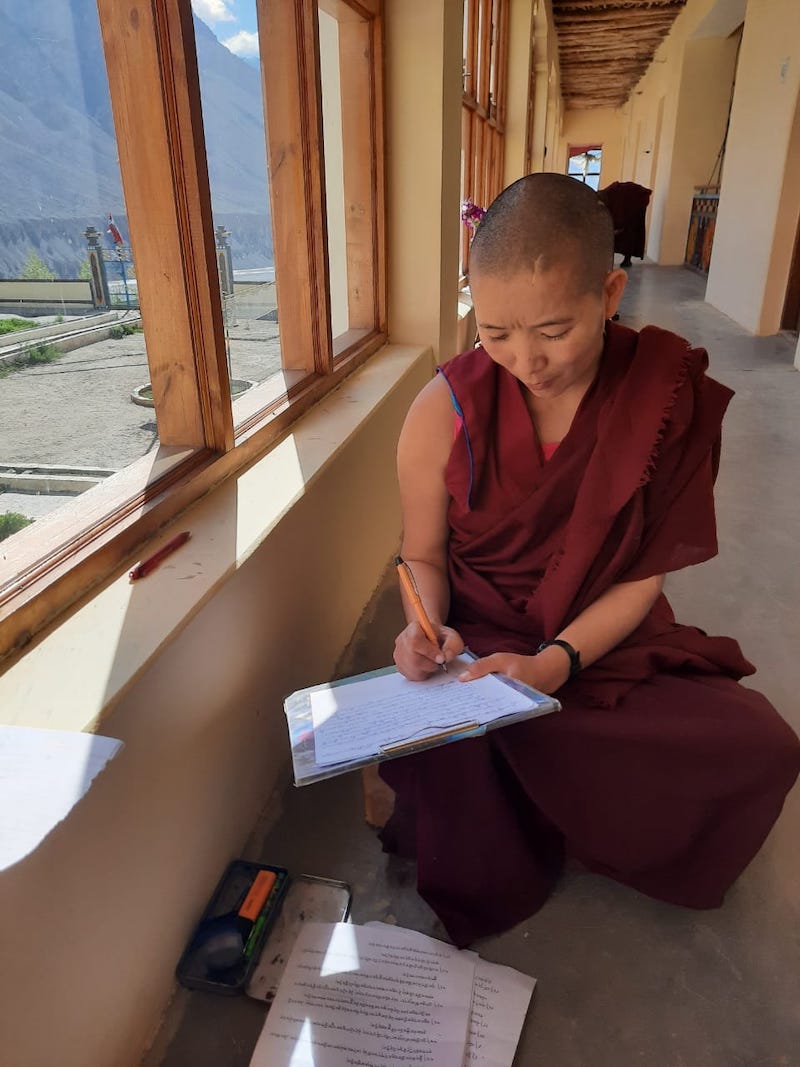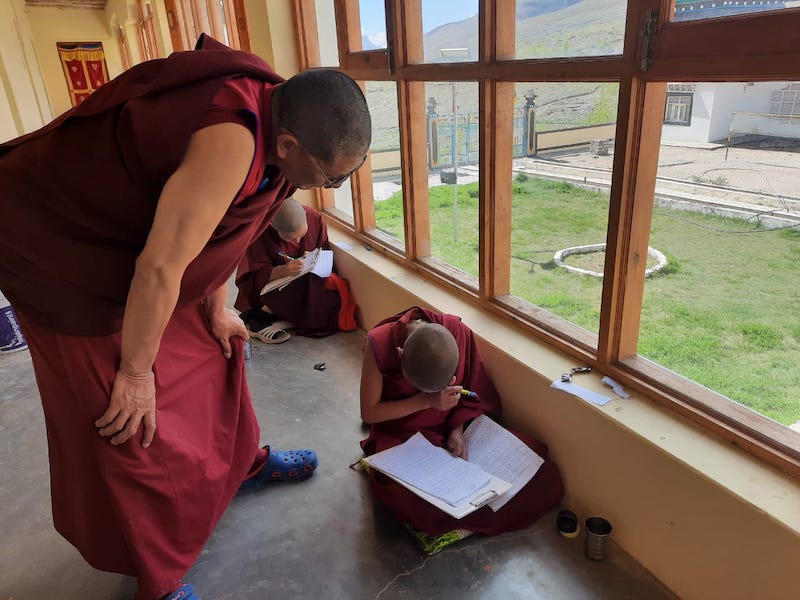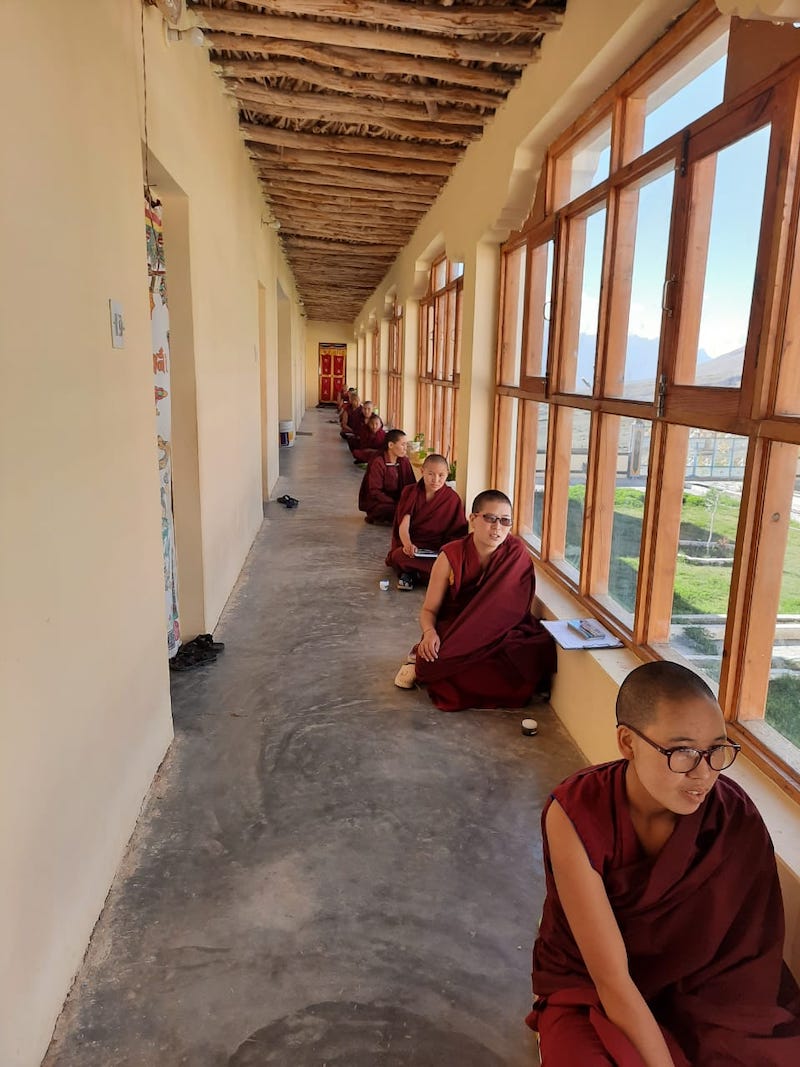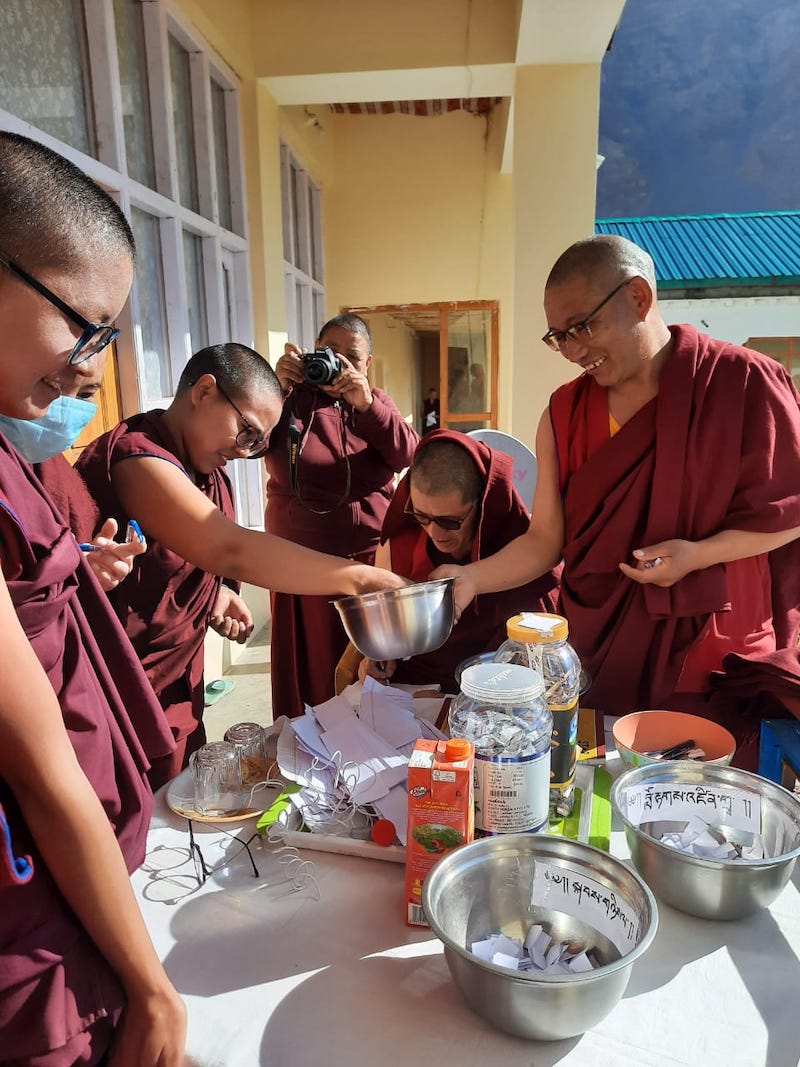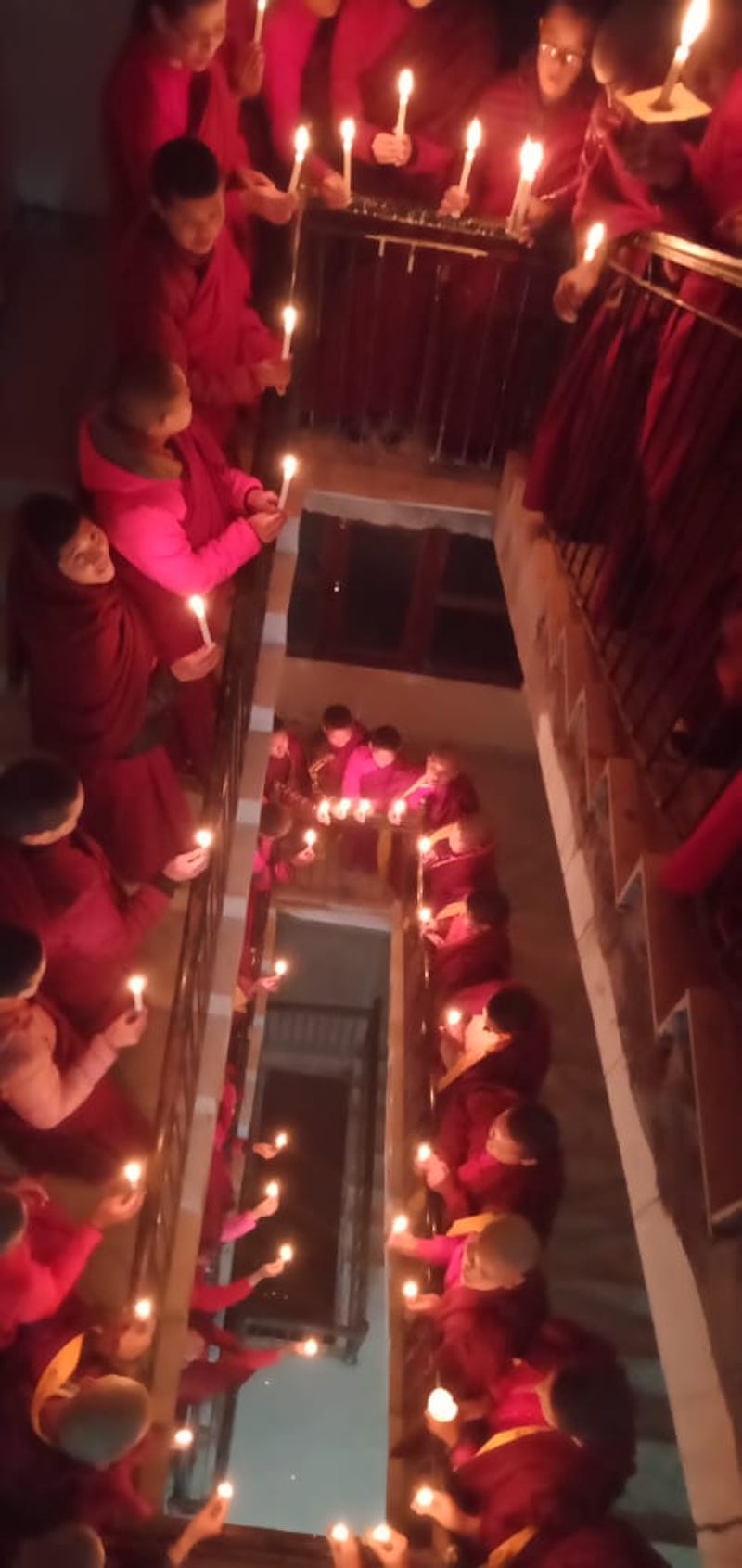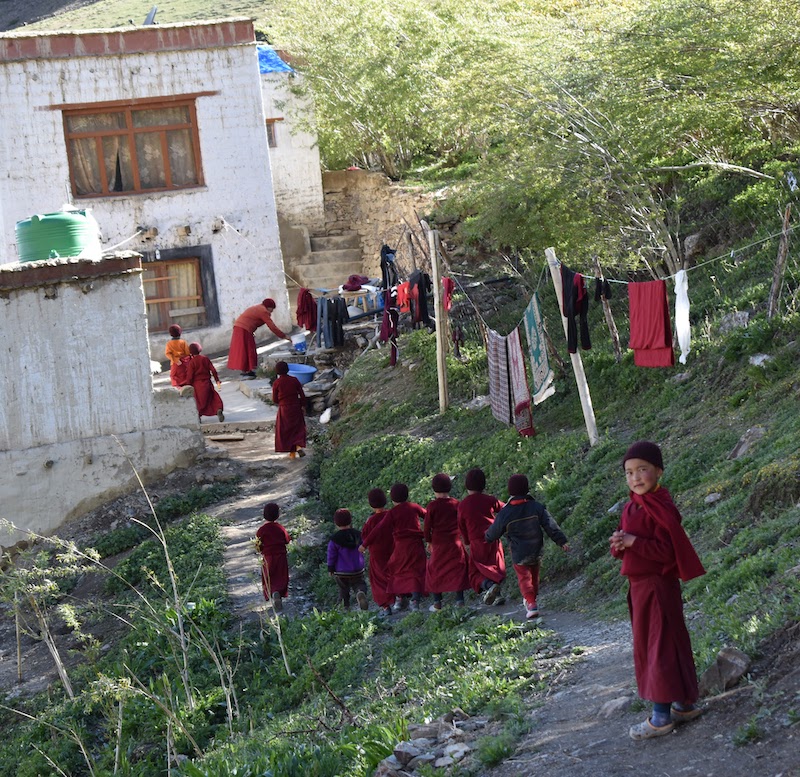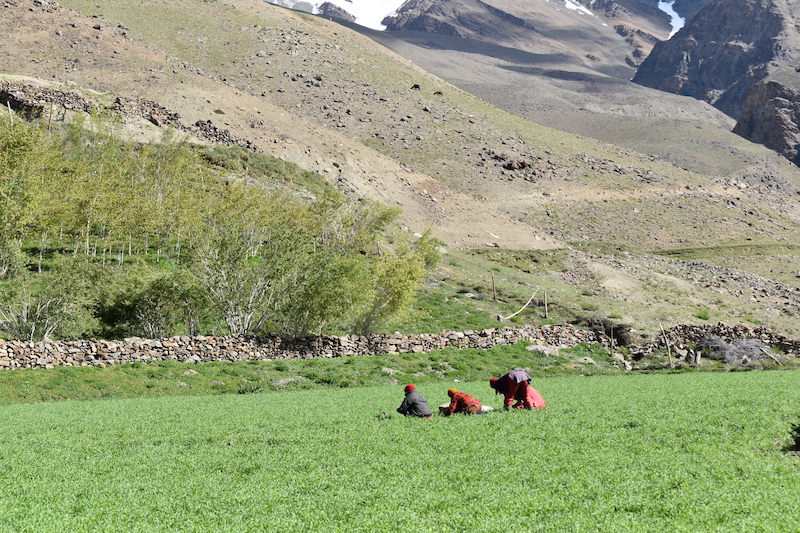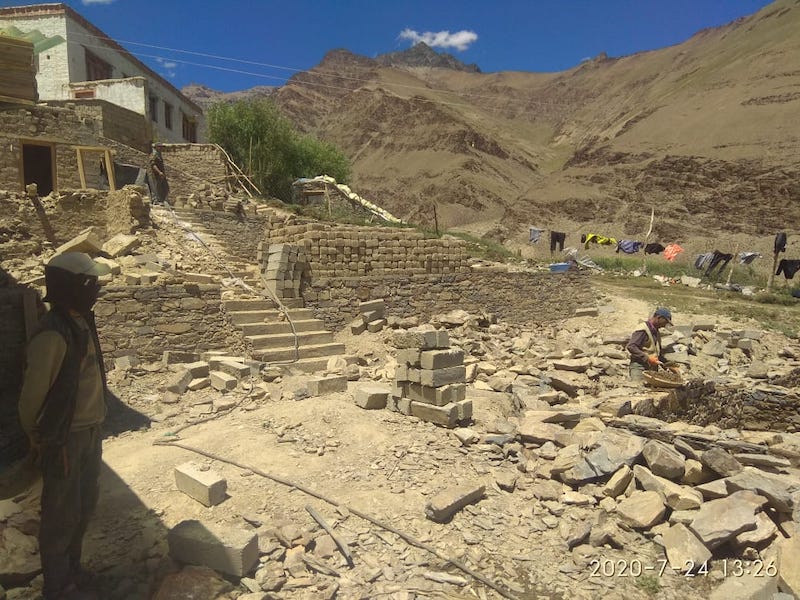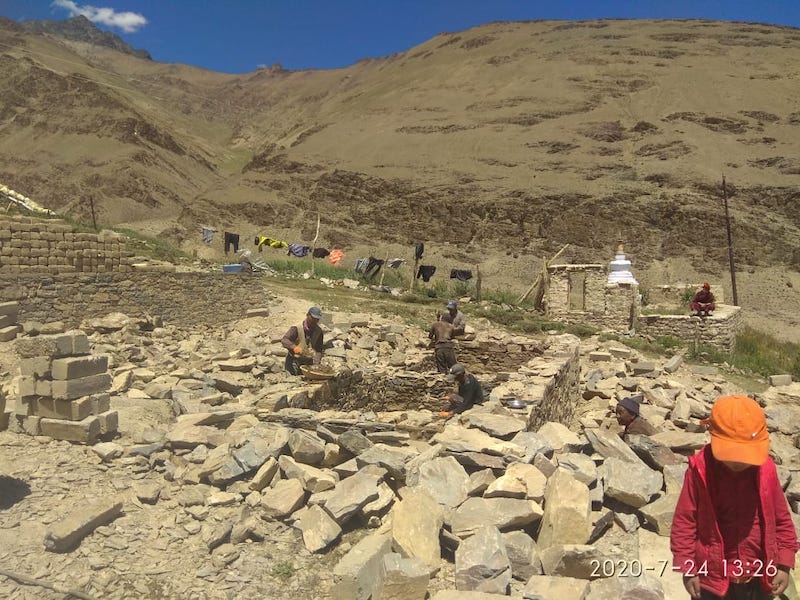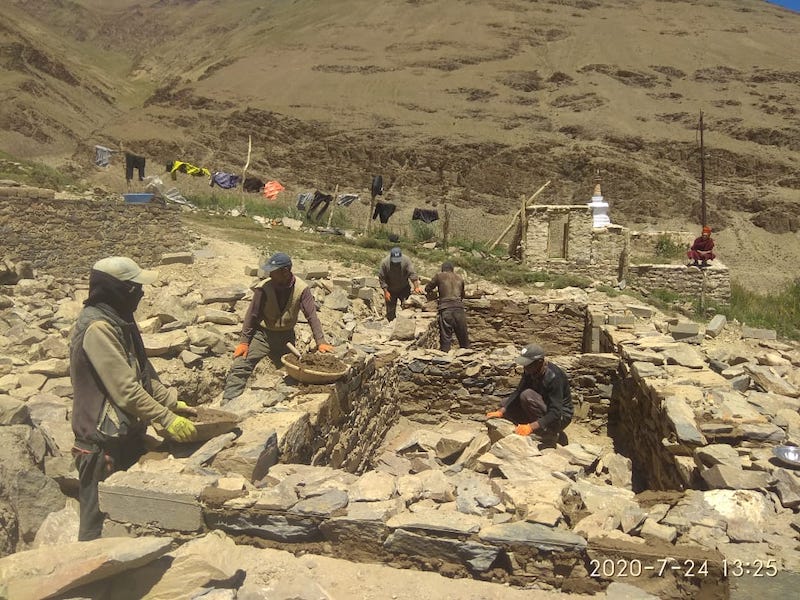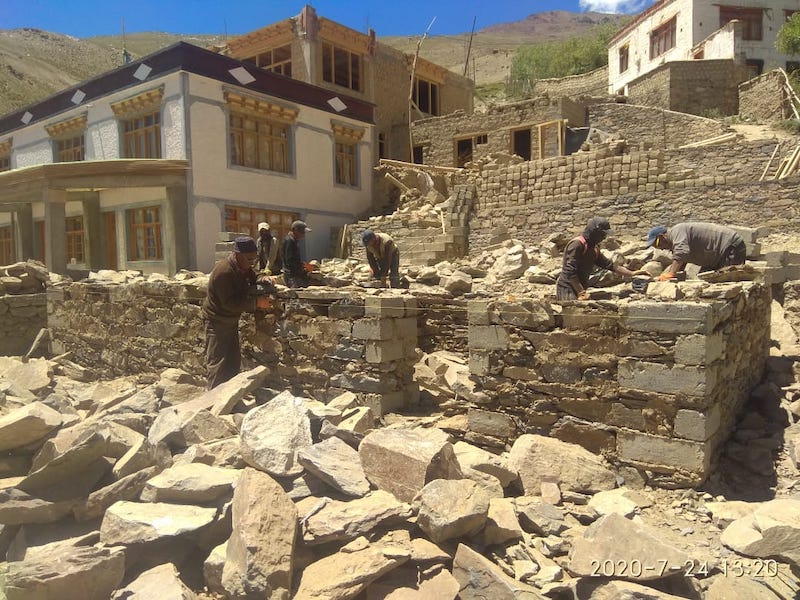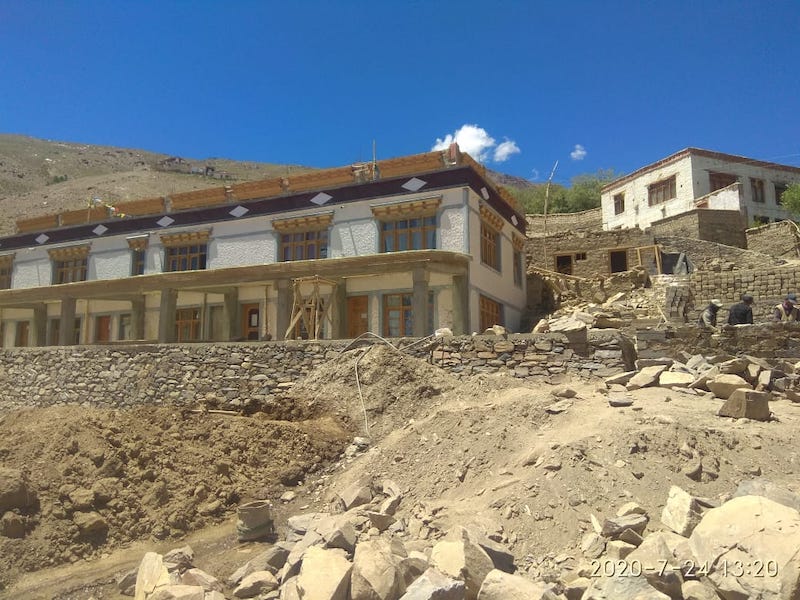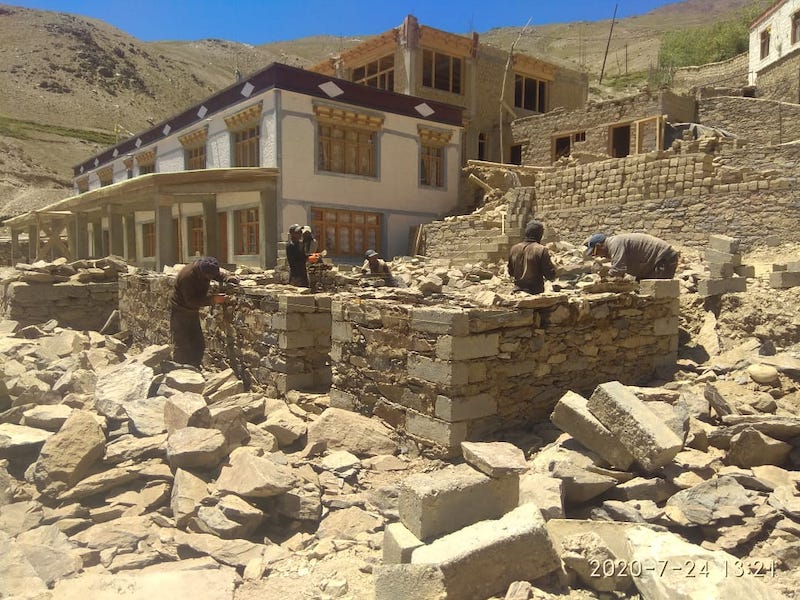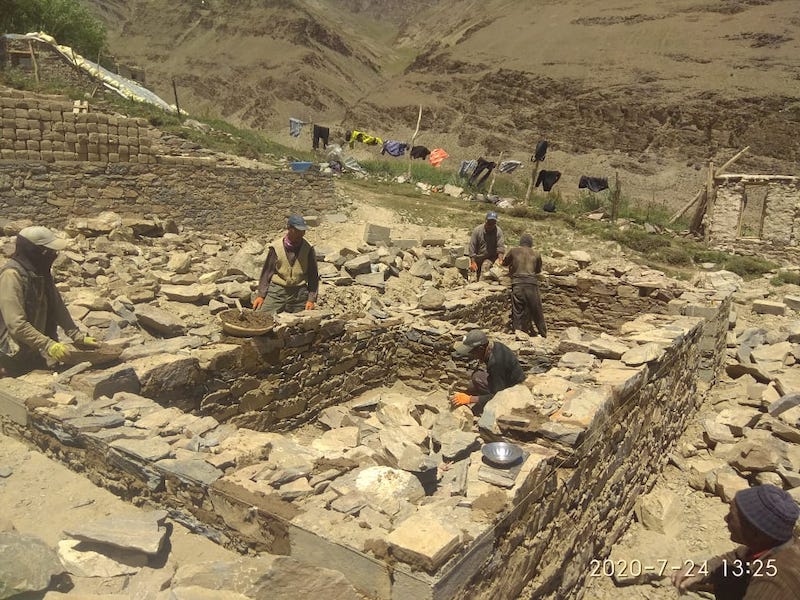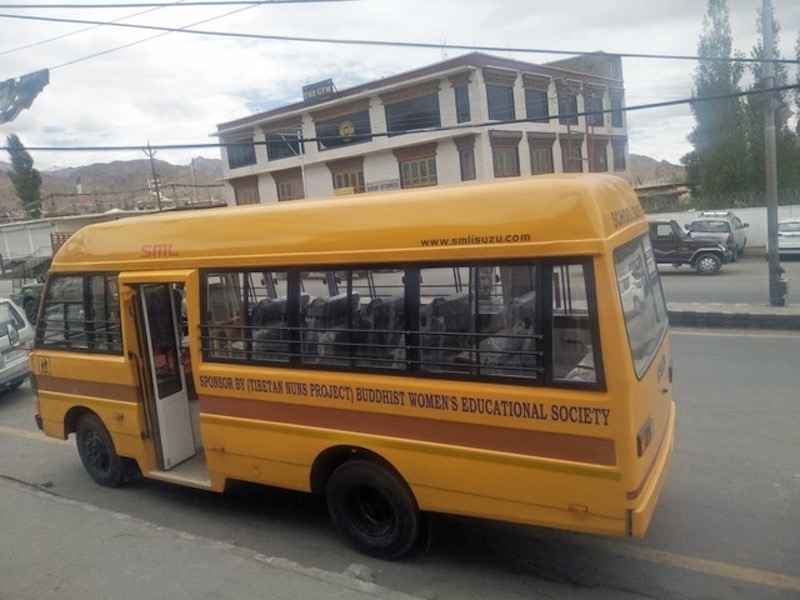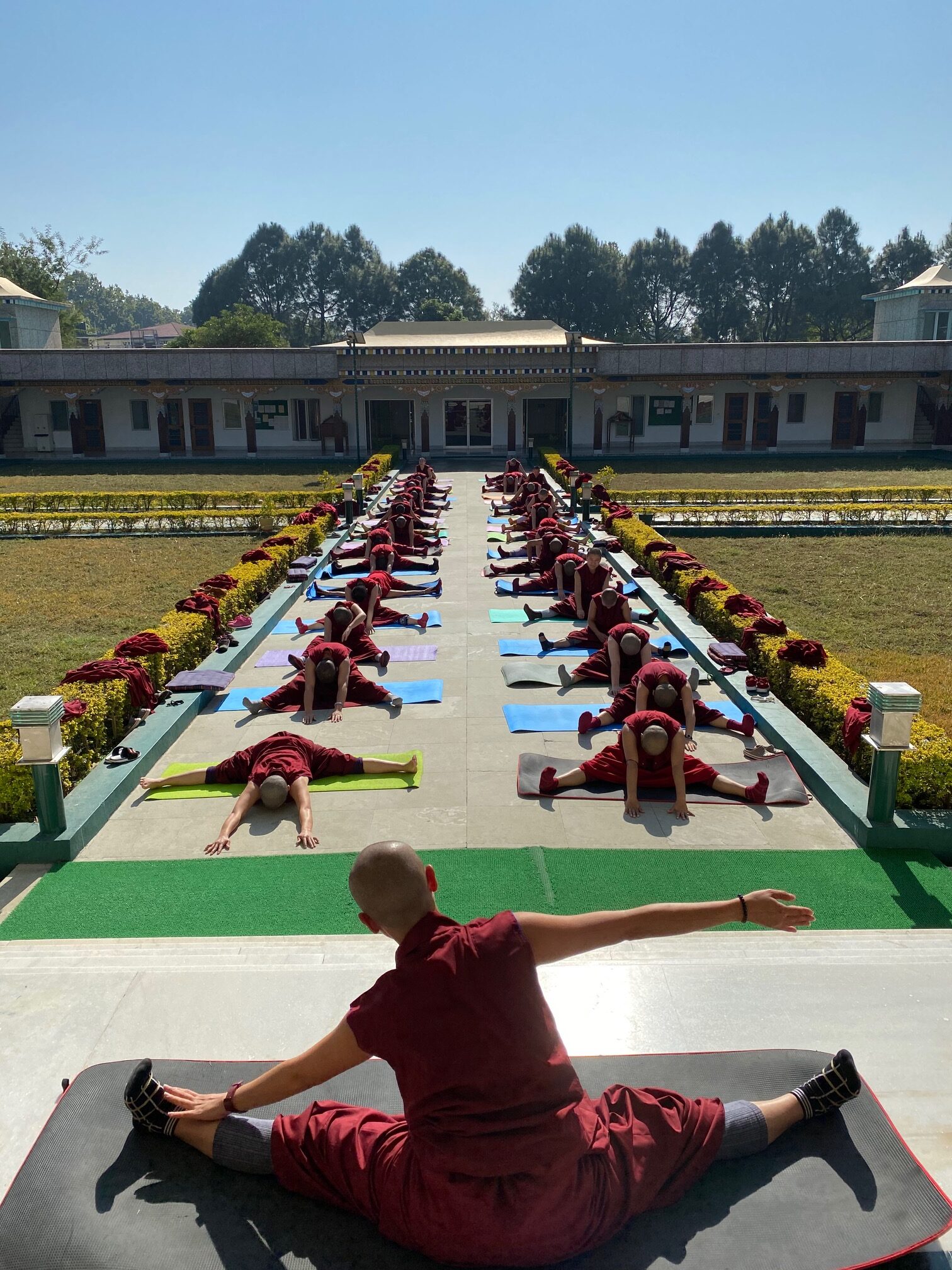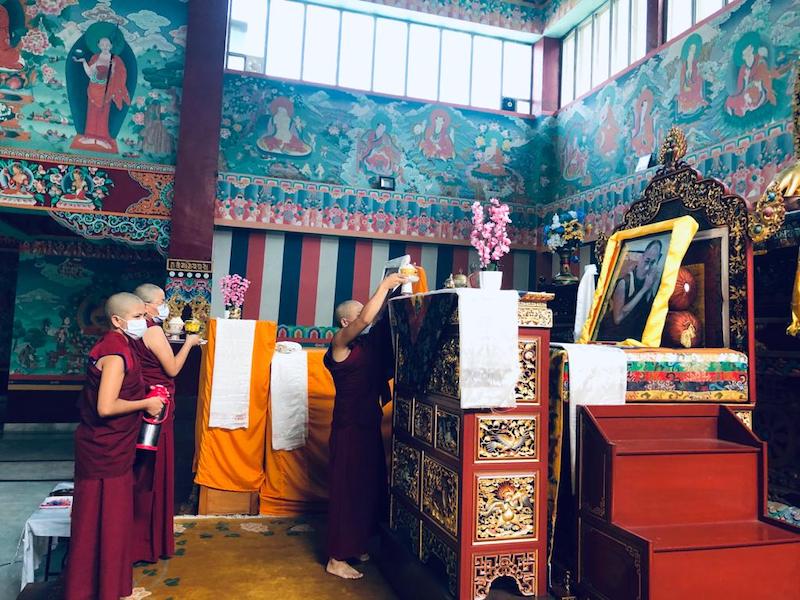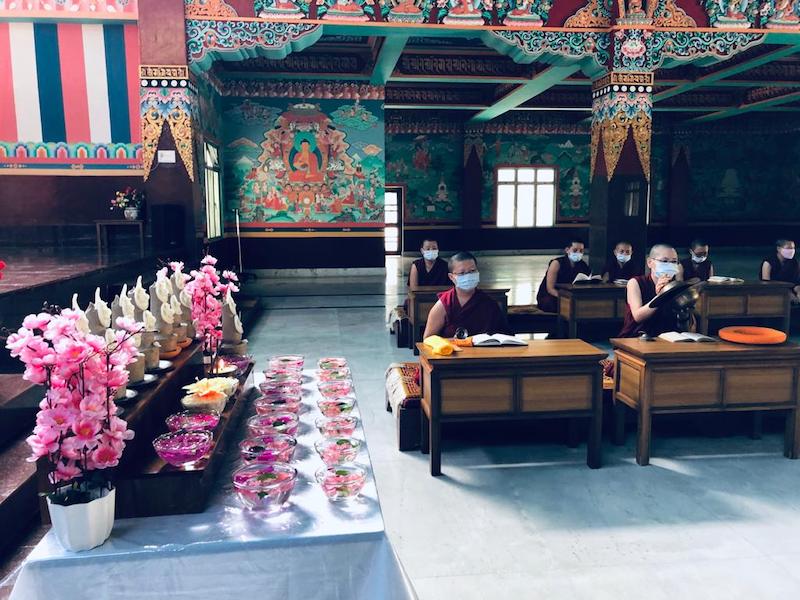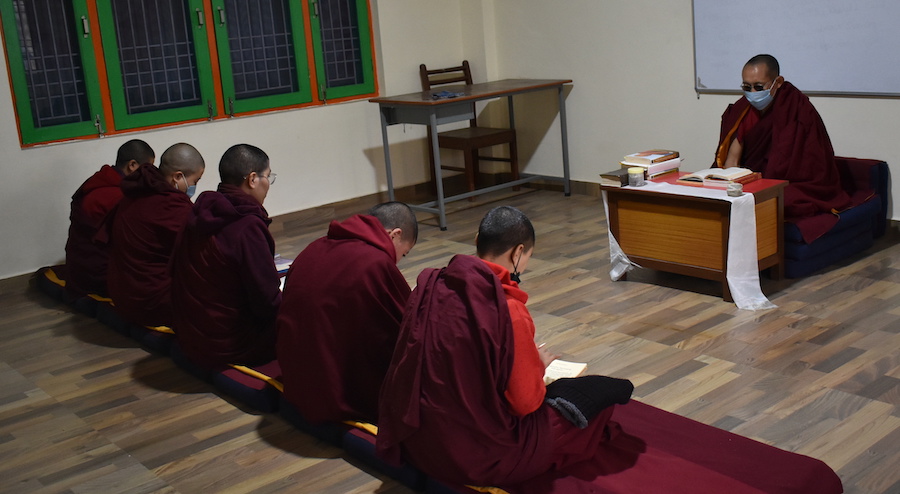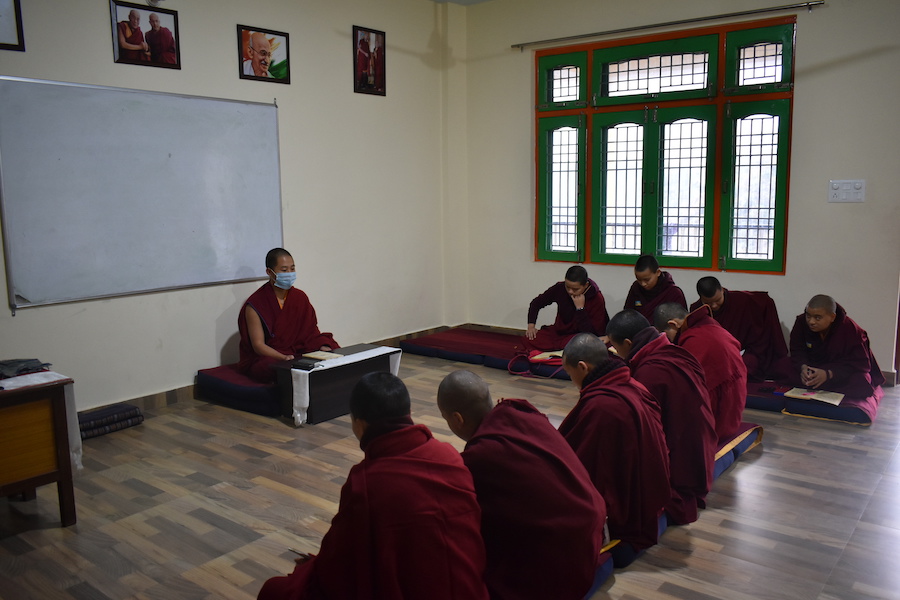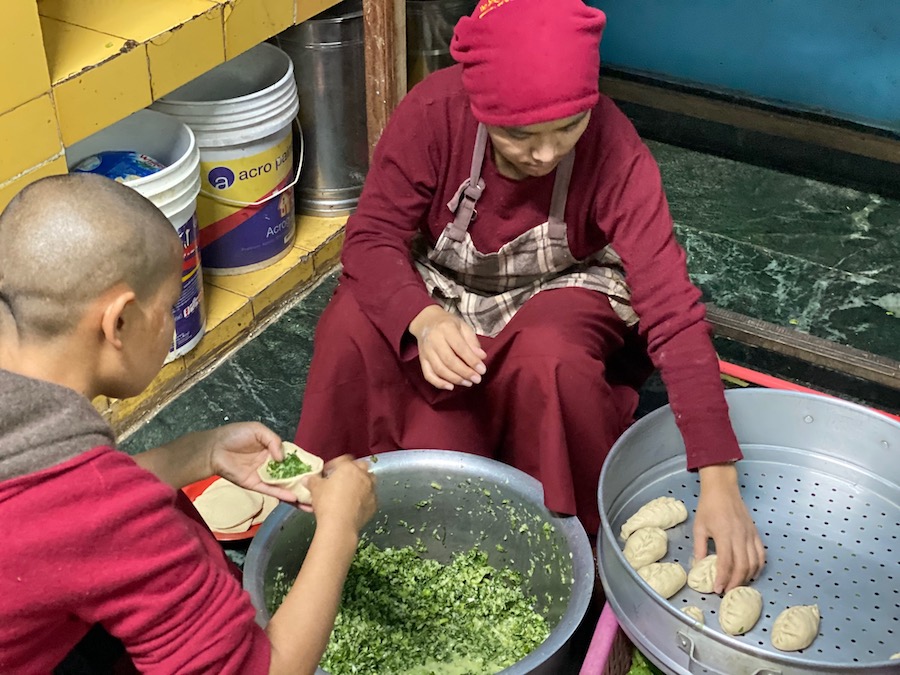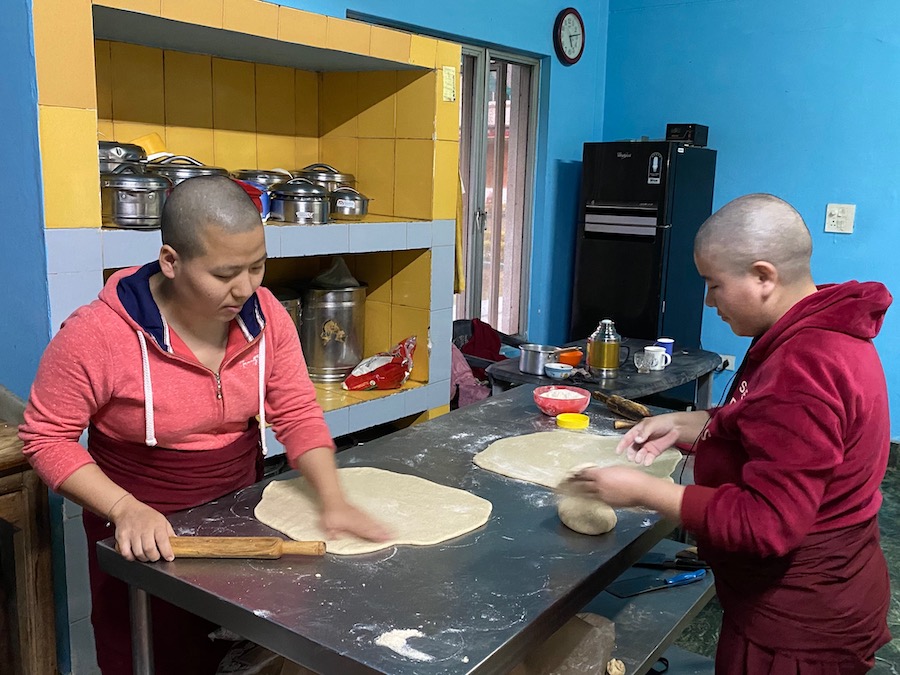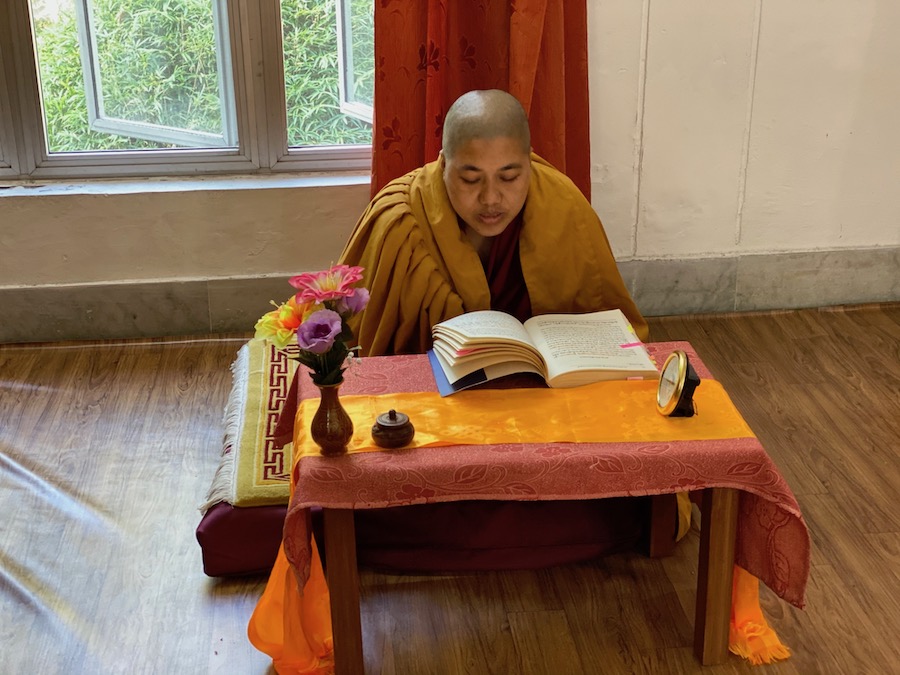As 2020 draws to a close, we wanted to update you with slideshows and news from all the nunneries and institutions in India that we support. if you sponsor a nun, scroll down to her nunnery and find the associated slideshow.
Dolma Ling Nunnery and Institute
HERE’S A SLIDESHOW OF LIFE AT DOLMA LING. Can’t see it? Click HERE.
Due to the pandemic, the nunnery was put on lockdown from March 2020. Many of the nuns’ classes were put on hold until July, but the nuns continued to study on their own and also do prayers for all sentient beings during this difficult time. For safety, the nuns no longer gathered together for morning assembly, meals, or pujas. The nunnery has been closed throughout for outsiders, and staff and teachers were only allowed to go out of the nunnery complex once a week if necessary.

The main gate of the nunnery remains closed and notices have been posted to ensure that no one enters without permission. The nuns created a makeshift gatekeeper room and every day. two nuns wearing masks take turns to guard the gate, with an electronic thermometer, hand sanitizer, and materials to sanitize things such as food and fuel canisters ready to hand. Essentials such as vegetables, rice, flour, and fuel are kept at the gate under the sun for hours and sanitized properly before being brought into the nunnery.
During the holy month of Saga Dawa which this year ran from May 23 to June 21, the nuns once again read the Kangyur, the spoken words of the Buddha, and Tengyur, the Tibetan collection of commentaries to the Buddhist teachings. Together, the 108-volume Kangyur and the 225-volume Tengyur form the basis of the Tibetan Buddhist canon. The texts were divided among the nuns. The nuns maintained physical distancing while reciting the texts in their rooms, on the verandahs, in the dining hall, and in the prayer hall. It took about three days for the nuns to complete the reading of the whole set. The nuns also marked Saga Dawa with the burning of juniper branches.
On August 24, the nuns held their annual academic award ceremony, an event that usually takes place in late March or early April. It was the first time since the pandemic began that the nuns assembled in such a big group. Rinchen Khando Choegyal, Founding Director and Special Advisor for the Tibetan Nun’s Project, was the guest of honor and other special guests were Mrs. Nangsa Choedon, Director of Tibetan Nuns Project and Mr. Norman Steinberg. The nuns received awards for academic achievement in their classes, the inter-house quiz competition, the handwriting competition, and memorization exams.
Since good nutrition is crucial for health, particularly in times when the immune system might need to fight back. the nuns are regularly making tofu for meals. Fruits and vegetables and juices are given to the nuns. Meals are eaten in the nuns’ respective rooms or apart in the courtyard.
Shugsep Nunnery and Institute
HERE’S A SLIDESHOW OF LIFE AT SHUGSEP. Can’t see it? Click HERE.
When the first lockdown of the year was announced, the senior nuns were in Bylakuppee, South India to where they were attending a special teaching from Khenchen Namdrol Rinpoche. With the travel restrictions, the senior nuns had to remain in south India for a couple of months. Eventually, the senior nuns were able to return to Shugsep they quarantined for the required period. After the quarantine, they took COVID-19 tests and all tested negative.
 To prevent the disease from spreading inside the nunnery, we shut the gate to visitors and all the transactions for prayers were done online. We had the basic necessities delivered to our gate so that we could stay isolated. We also barred the staff and students from leaving the nunnery grounds until and unless it was urgent. Weekend outings for the students were cancelled and the staff were strictly instructed not to leave the premises without permission.
To prevent the disease from spreading inside the nunnery, we shut the gate to visitors and all the transactions for prayers were done online. We had the basic necessities delivered to our gate so that we could stay isolated. We also barred the staff and students from leaving the nunnery grounds until and unless it was urgent. Weekend outings for the students were cancelled and the staff were strictly instructed not to leave the premises without permission.
In mid-June, the results of the annual exams for 2019-20 were announced and classes for 2020 officially began in July. At the beginning of August, the summer retreat started and lasted for 45 days from August 4 to September 17. During that period, we organized a lot of debates, essay competitions, and public speaking for the students.
Recently, Shugsep Nunnery and Institute had a drawing competition among the younger students and we are glad that all of them participated and showed their talents. Classes stopped on December 14th for the annual examinations with a study holiday of one week after every test. The examinations begin on December 24th and the last tests will be on January 25th.
December 7, 2020, marked the tenth anniversary of the inauguration of Shugsep Nunnery and Institute by His Holiness the Dalai Lama.
Geden Choeling Nunnery
HERE’S A SLIDESHOW OF LIFE AT GEDEN CHOELING. Can’t see it? Click HERE.
At the outbreak of the COVID-19 pandemic, all the major routine activities of the nuns such as in-person classes, debating practice, group religious activities, and other social and cultural gatherings were stopped. However, the ten nuns preparing for the Geshema exams continued to attend regular classes taught by the three Buddhist philosophy teachers. All the other nuns have been learning through online classes run by their respective teachers who also provide notes and homework. The nuns memorize texts and are doing well in their studies in their rooms and are always in touch with their teachers.

In terms of health care and emotional matters, all the nuns are in good health. They received frequent talks and advice from Geden Choeling Nunnery’s Abbot, office administrator, teachers, and Gekoe (Disciplinarian) to keep them mentally strong without any fear and anxiety during this pandemic period.
All the nuns and staff members are restricted from visiting outside places and the market area since the outbreak of the COVID-19 pandemic. No visitors are allowed in the institute, except for prayer offerings by the well-wisher. The nuns maintain daily hygiene and sanitation using sanitizing spray for COVID-19.
Finally, the nuns hold regular prayer sessions twice a day from 6-7:30 a.m. and from 3:30 to 4:30 pm.
Tilokpur Nunnery
HERE’S A SLIDESHOW OF LIFE AT TILOKPUR. Can’t see it? Click HERE.
Here’s an update on the current condition of Karma Drubgyu Thargay Ling at Tilokpur and the nuns’ activities and initiatives over the last couple of months during this pandemic. In general, so far, the 87 nuns are mentally and physically healthy and doing well. To cope with this pandemic, they are strictly following all the basic instructions provided by the government and their medical assistant, such as hand sanitizing, wearing masks, and maintaining physical distancing. The nuns are still not allowed to leave the nunnery except for the kitchen runner. No visitors are allowed to enter the nunnery grounds.

Tibetan Buddhist nuns at Tilokpur Nunnery receiving handknitted sweaters, hats, and mittens donated by the volunteers at Wool-Aid
In December, the nuns received two large boxes of handknitted sweaters, hats, and mittens donated by the volunteer knitters at Wool-Aid.
In terms of education and other activities, the nuns are continuing with their philosophy classes, monastic debate practice, and computer learning in person, with only English classes being taught online. The younger nuns are also learning painting and drawing. The nunnery holds two prayer sessions each day, in the morning and evening, to pray for all sentient beings and for the betterment of this world.
The nuns wrote, “We are making our best attempt not to get caught with any virus in the community so everyone remains safe and healthy. We hope that this pandemic will finish soon and that everyone can enjoy normal living.
Sherab Choeling Nunnery
HERE’S A SLIDESHOW OF LIFE AT SHERAB CHOELING. Can’t see it? Click HERE.
When the pandemic hit in mid-February 2020, 44 of the nuns from Sherab Choeling were away from the nunnery in the town of Hamirpur so that they could continue their philosophy classes with their philosophy teachers who were there. Shortly after, the coronavirus lockdown in India happened and all classes were suspended. Eventually, the nuns were able to arrange for two buses to take them and their two teachers back to Sherab Choeling.
The Tibetan Buddhist nuns at Sherab Choeling Nunnery in the remote Spiti Valley marked the holy month of Saga Dawa as always with prayers, the lighting of butter lamps, fasting, and vows. During the holy month, the nuns also received puja requests from villagers for their late family members and for their own well-being. The nuns also offered the Medicine Buddha ritual as requested by many people. Most of the nuns fasted during the entire month, taking no meals after lunch.
Dorjee Zong Nunnery
HERE’S A SLIDESHOW OF LIFE AT DORJEE ZONG. Can’t see it? Click HERE.
Dorjee Zong Nunnery is one of the oldest centres of monastic education in Zanskar and has a long tradition of meditating nuns, some of who are famed for having reached high levels of realization. This remote 700-year-old nunnery now provides much-needed educational opportunities for young girls and women.

In 2019, Dorjee Zong began a major expansion project and good progress was made last year. The housing block and the structure of a multi-purpose two-story building were completed before extreme weather shut down construction in October. The two-story building contains the kitchen, dining hall, storeroom on the ground floor and, on the upper floor, the prayer hall and a conference hall.
When the coronavirus pandemic hit India in the spring, we feared that no construction would be possible because most of the labor force comes from Nepal and strict restrictions would prevent their travel. However, in July and August, the nunnery was able to move forward gradually with the building process.
As life after the nationwide lockdown in the spring began slowly getting back on track, the nuns’ committee decided to move forward to complete the interiors of the multi-purpose building with work such as plastering of the floors, electrical work fittings etc. They have also undertaken the construction of the bathroom and toilet block needed to go with the housing block. Around six to seven local village workers were hired for this job because outside laborers were stopped from coming to Zanskar. All labor work this summer was done by local village people under the guidance of the working committee.
Currently, the housing block is being used as living quarters on the ground floor for the young nuns, while the top-floor rooms are being used for multiple purposes including as temporary classrooms, office, and a meeting room.
During the lockdown, the younger nuns from nearby villages temporarily left the nunnery to stay with their families. These young nuns were not able to stay at Dorjee Zong because there is not enough space to house them in separate quarters or to follow safe physical distancing measures. Their elder siblings who have returned home are helping the younger children with their studies.
In 2019, generous donors funded the purchase of a school bus to enable the young nuns at Dorjee Zong to continue their education. The nuns needed a school bus to make the 12-mile round-trip journey to the government school to continue their education beyond Grade 5. The bus has arrived in Zanskar and is ready for use. Unfortunately, due to the coronavirus pandemic, the schools in India are currently closed. We will keep you updated.
Sakya College for Nuns
HERE’S A SLIDESHOW OF LIFE AT SAKYA COLLEGE FOR NUNS. Can’t see it? Click HERE.
Sakya College for Nuns is situated in Manduwala, about 12 miles from Dehradun and is home to 55 nuns. It is one of the seven nunneries and institutes of higher learning in India supported by the Tibetan Nuns Project through our sponsorship program.
Like many other nunneries and monasteries, Sakya College for Nuns has been strictly observing lockdown since March this year. Although the lockdown has been lifted in many parts of India, the nuns consider to observe it with great care and caution. The College’s gates remain locked 24/7.
Since the start of the new academic session in July 2020, the nuns’ regular classes are proceeding as usual. Inside the campus, everything looks so normal, just as it used to be during the pre-COVID-19 times, that is with morning prayers, classes, debates, self-study and so on.
The only thing that is missing is the monthly outing that nuns enjoy every month. Because the nuns used to visit the market only about once a month, in that sense the pandemic and the lockdown has not greatly affected the nuns at Sakya College.
 Even so, as part of measures to provide emotional health care, a Vipassana meditation master and a yoga expert were invited to give workshops. The College invited Associate Professor Ramesh Chandra Negi from the Central University of Tibetan Studies and an expert in Vipassana meditation in the Theravada tradition to give a workshop for the nuns. The professor gave a 10-day course in Vipassana mediation and advised the nuns to continue the practice.
Even so, as part of measures to provide emotional health care, a Vipassana meditation master and a yoga expert were invited to give workshops. The College invited Associate Professor Ramesh Chandra Negi from the Central University of Tibetan Studies and an expert in Vipassana meditation in the Theravada tradition to give a workshop for the nuns. The professor gave a 10-day course in Vipassana mediation and advised the nuns to continue the practice.
Some of the nuns claim the course has been of immense help in terms of maintaining tranquillity and peace of mind. They have continued to practice individually since the workshop. As meditation is all about dealing with the mind, the main purpose of the workshop was to help the nuns keep their minds in peace and stress-free throughout the lockdown period.
The College had previously invited Tibetan yoga trainer Tsering Yangzom and, on two different occasions, she conducted a 10-day yoga workshop. This greatly motivated the nuns in keeping their bodies in proper health and shape in order to lead healthy, happy lives.
In the special update in mid-December 2020, the College wrote, “We believe that with the introduction of yoga and Vipassana mediation we ensure that our nuns are relatively more relaxed, healthier, and stronger physically and mentally. This, apart from the daily academic activities and curriculums, always keeps their body and mind busy and active.”
The Tibetan Nuns Project is extremely grateful to all those who sponsor nuns and to all our supporters. Thank you for your compassion and generosity!


